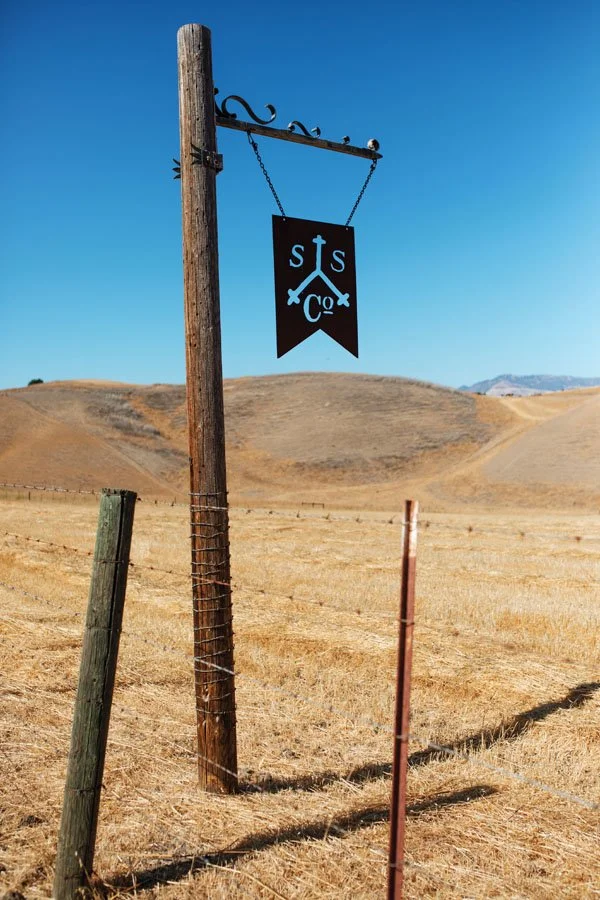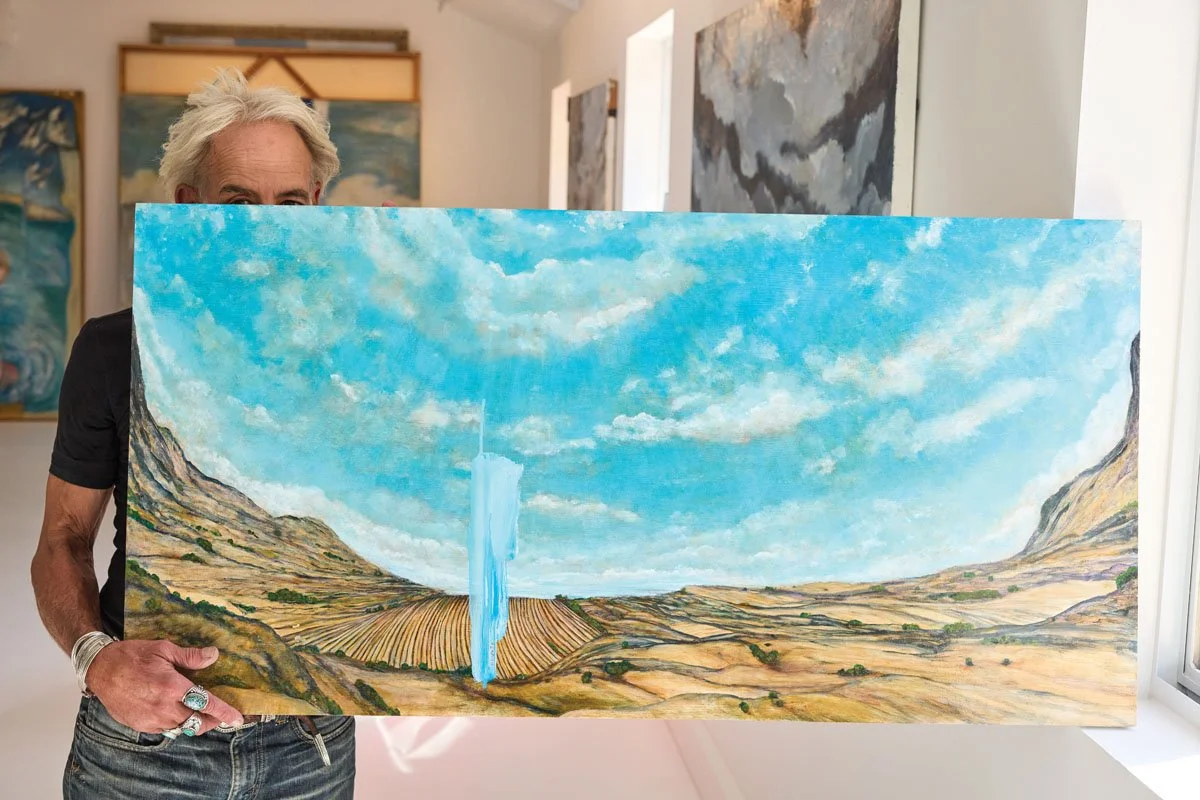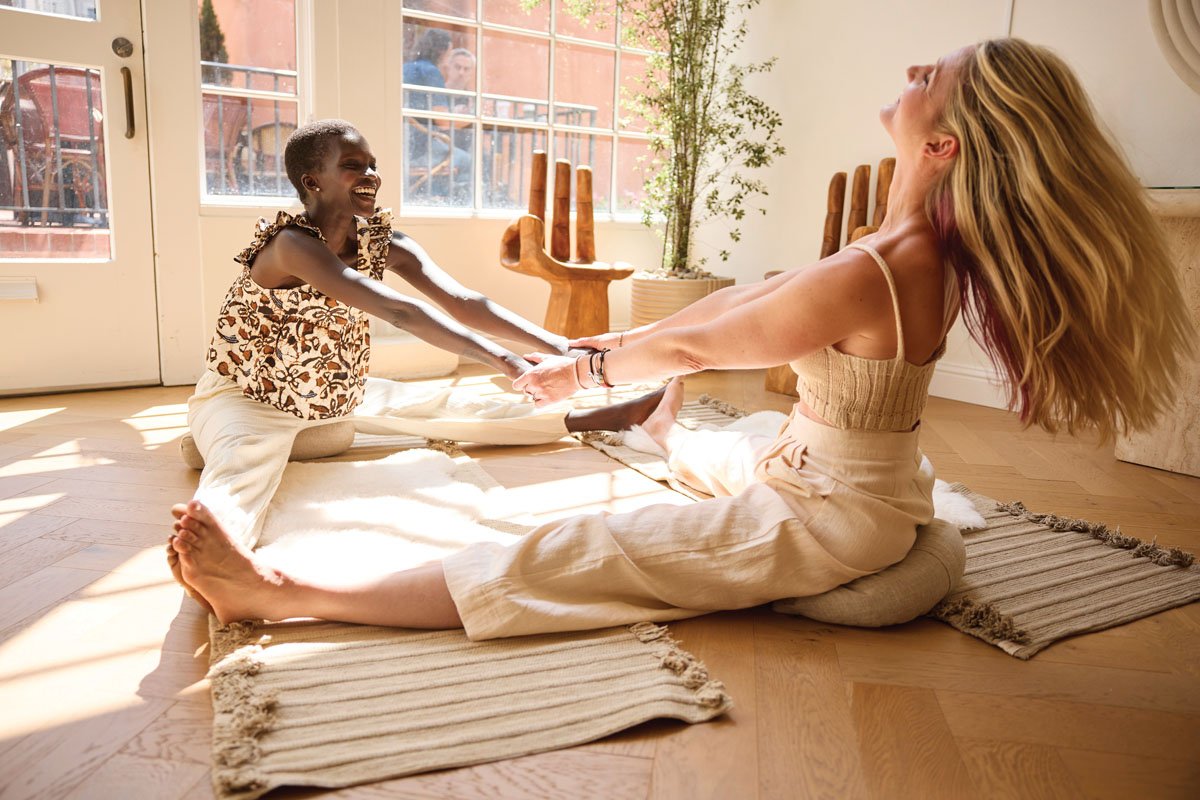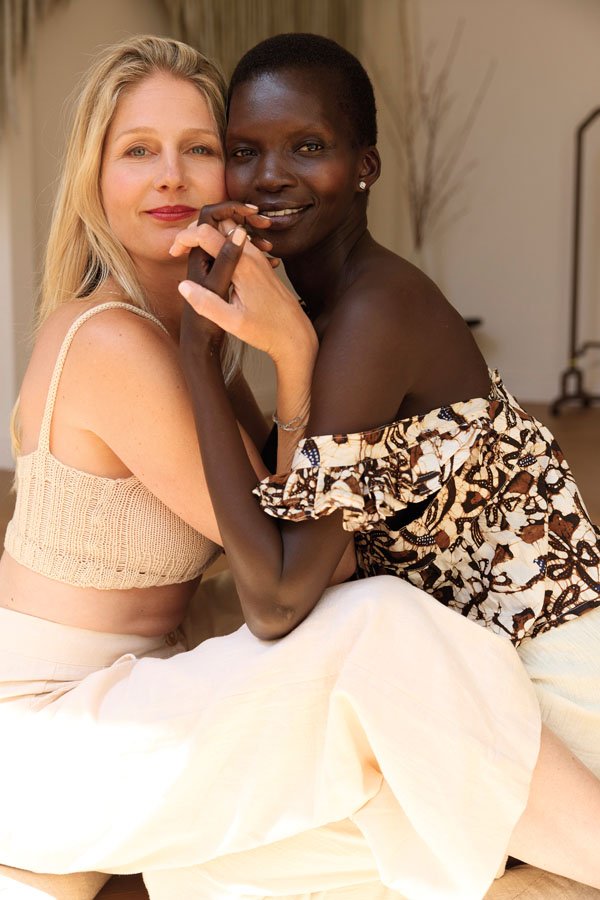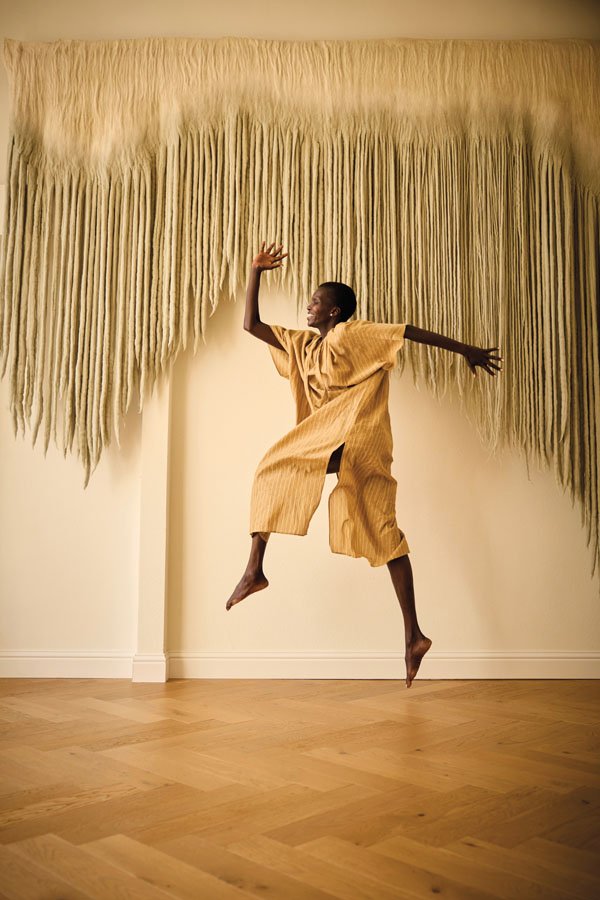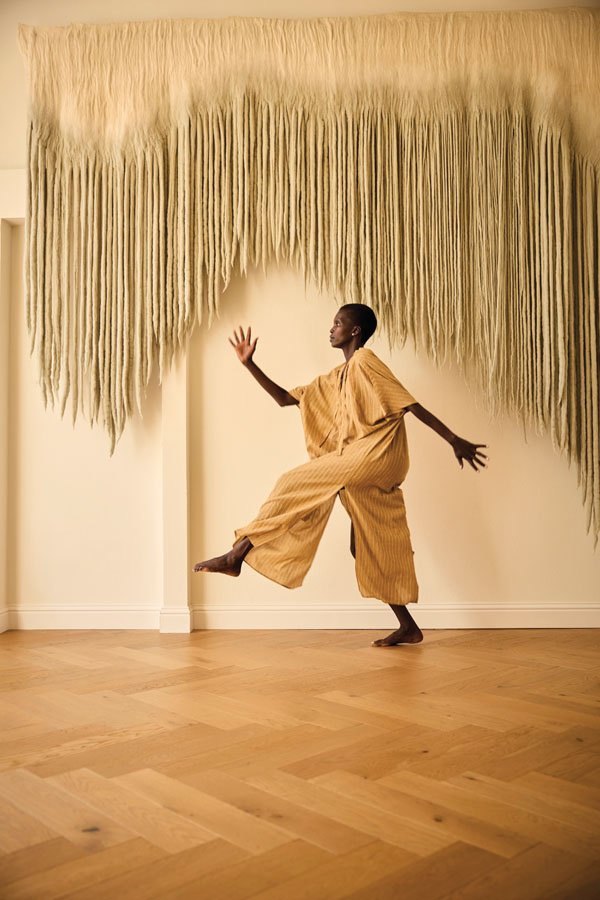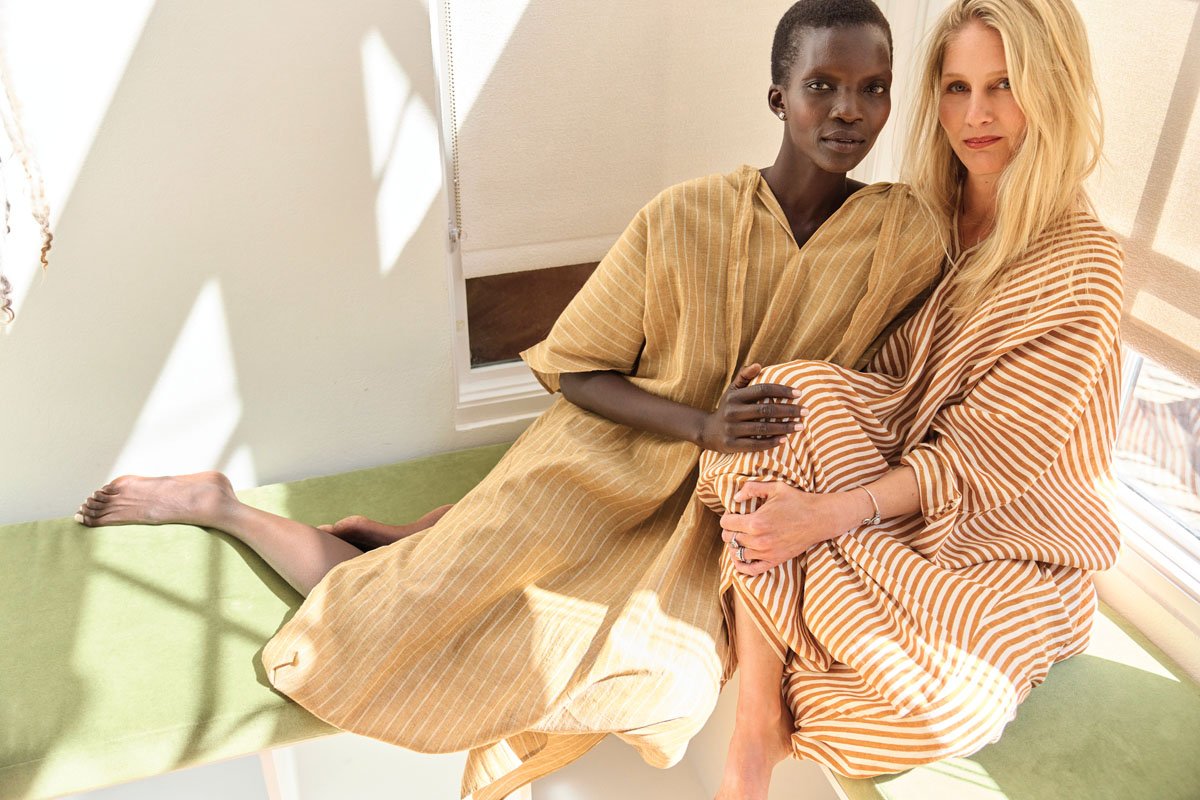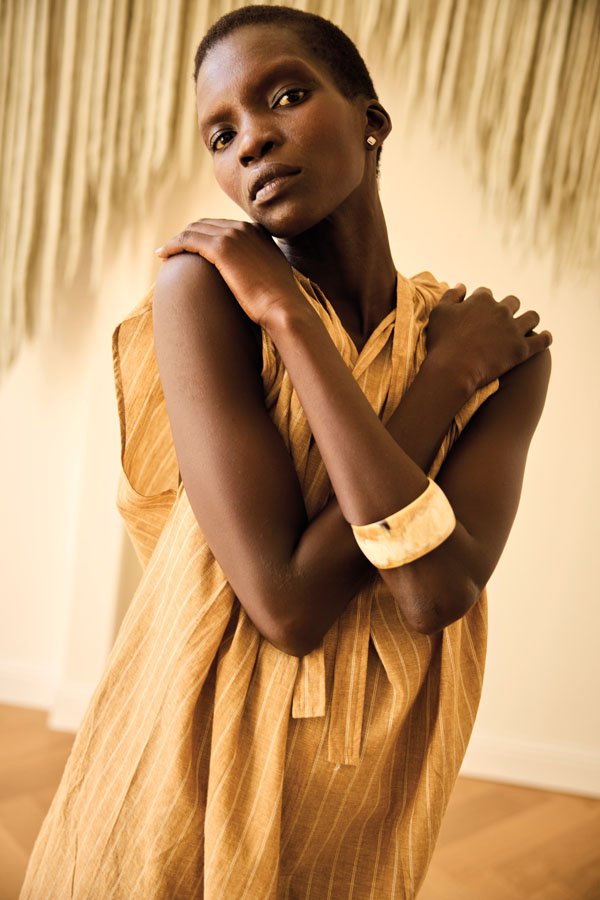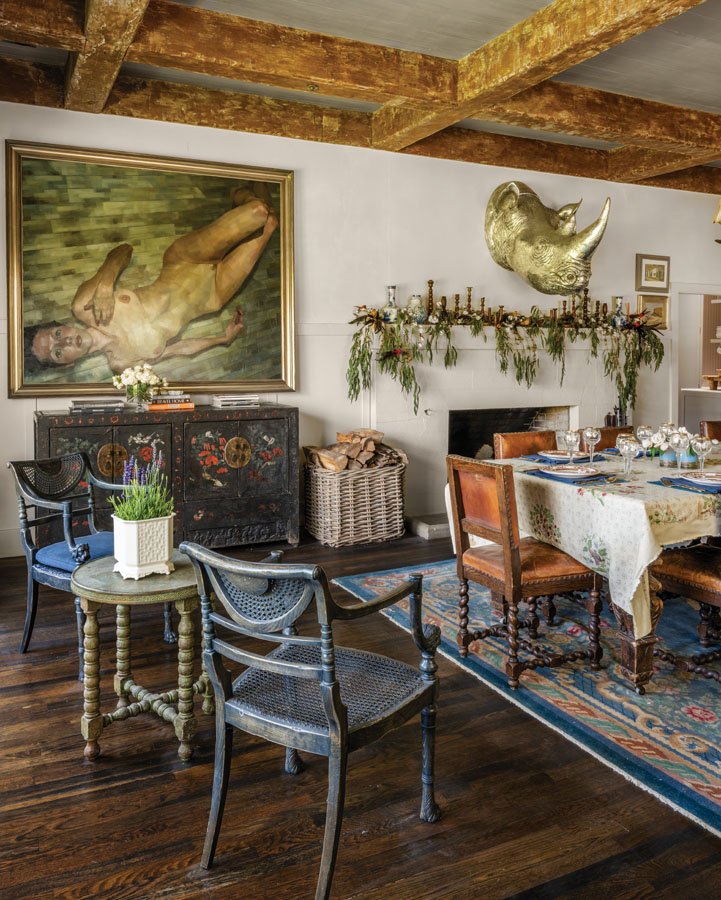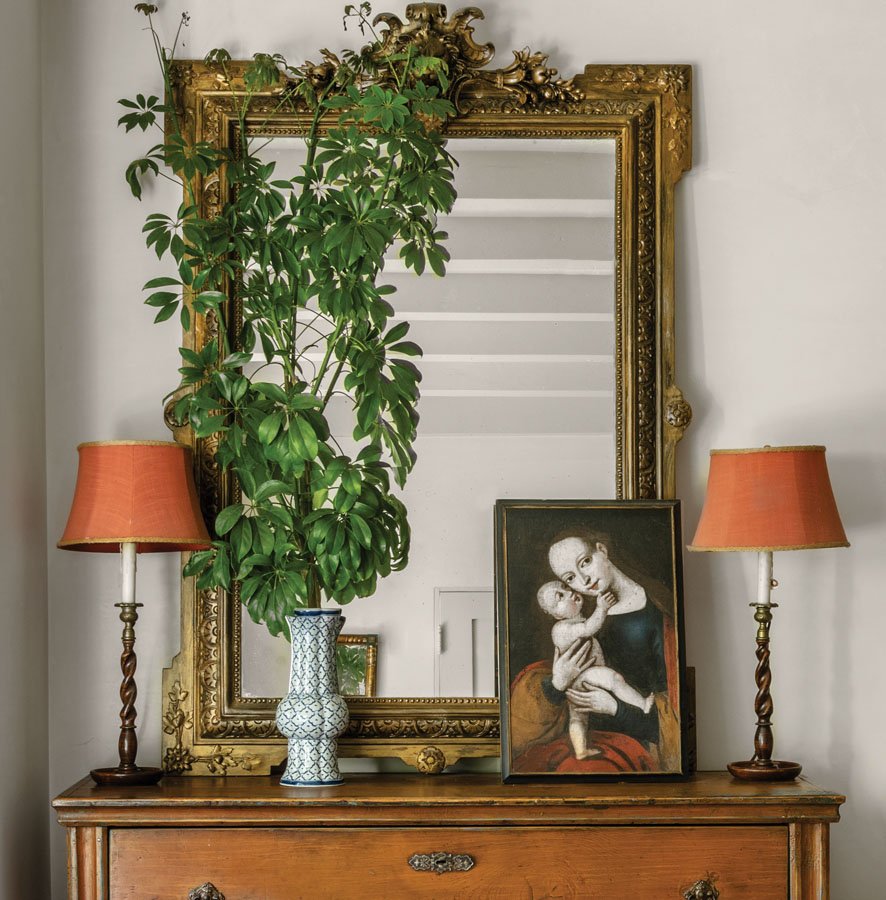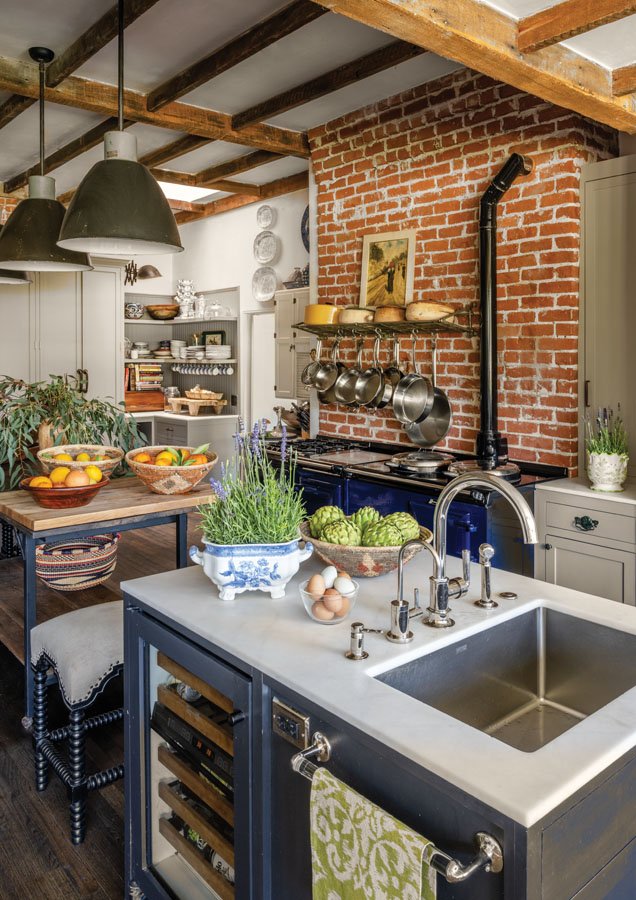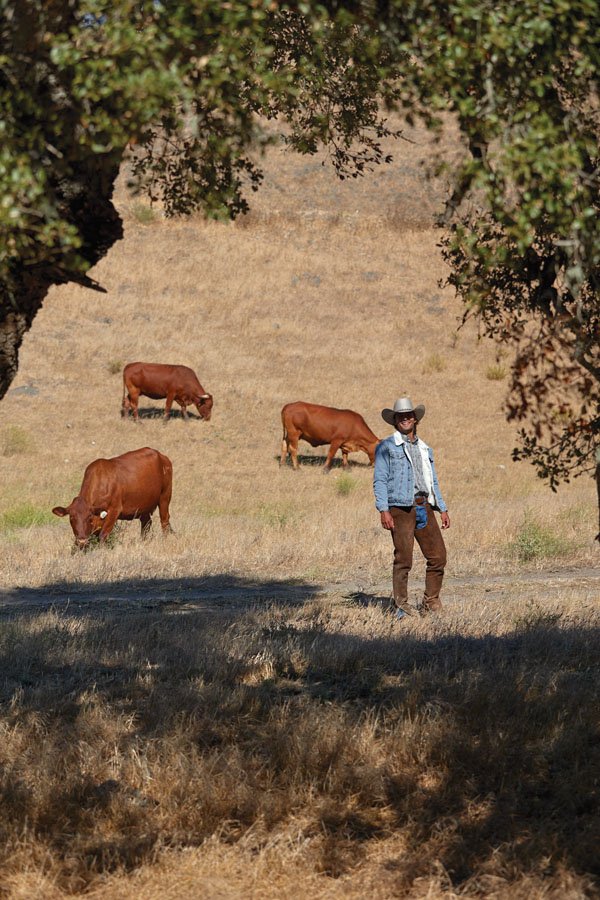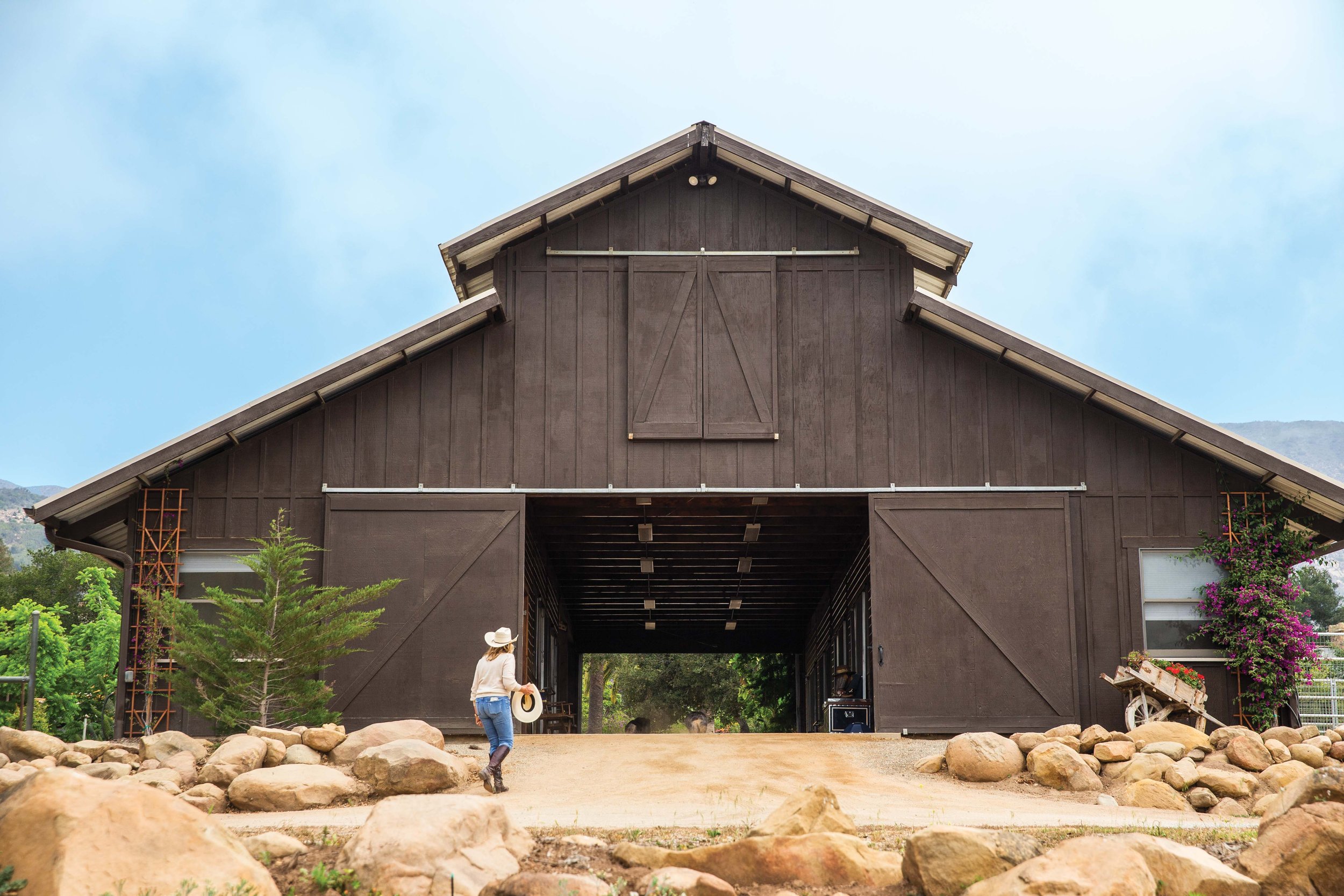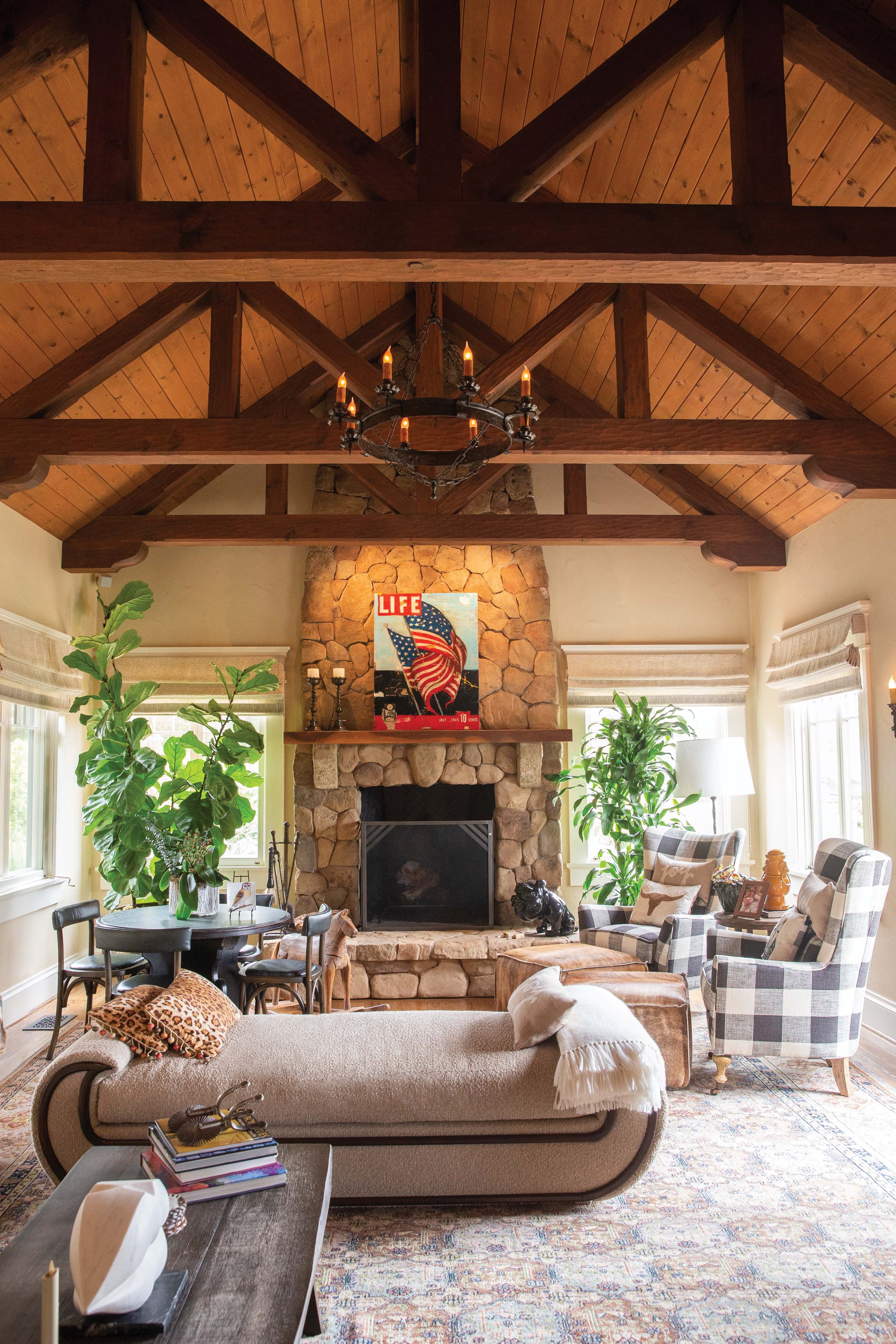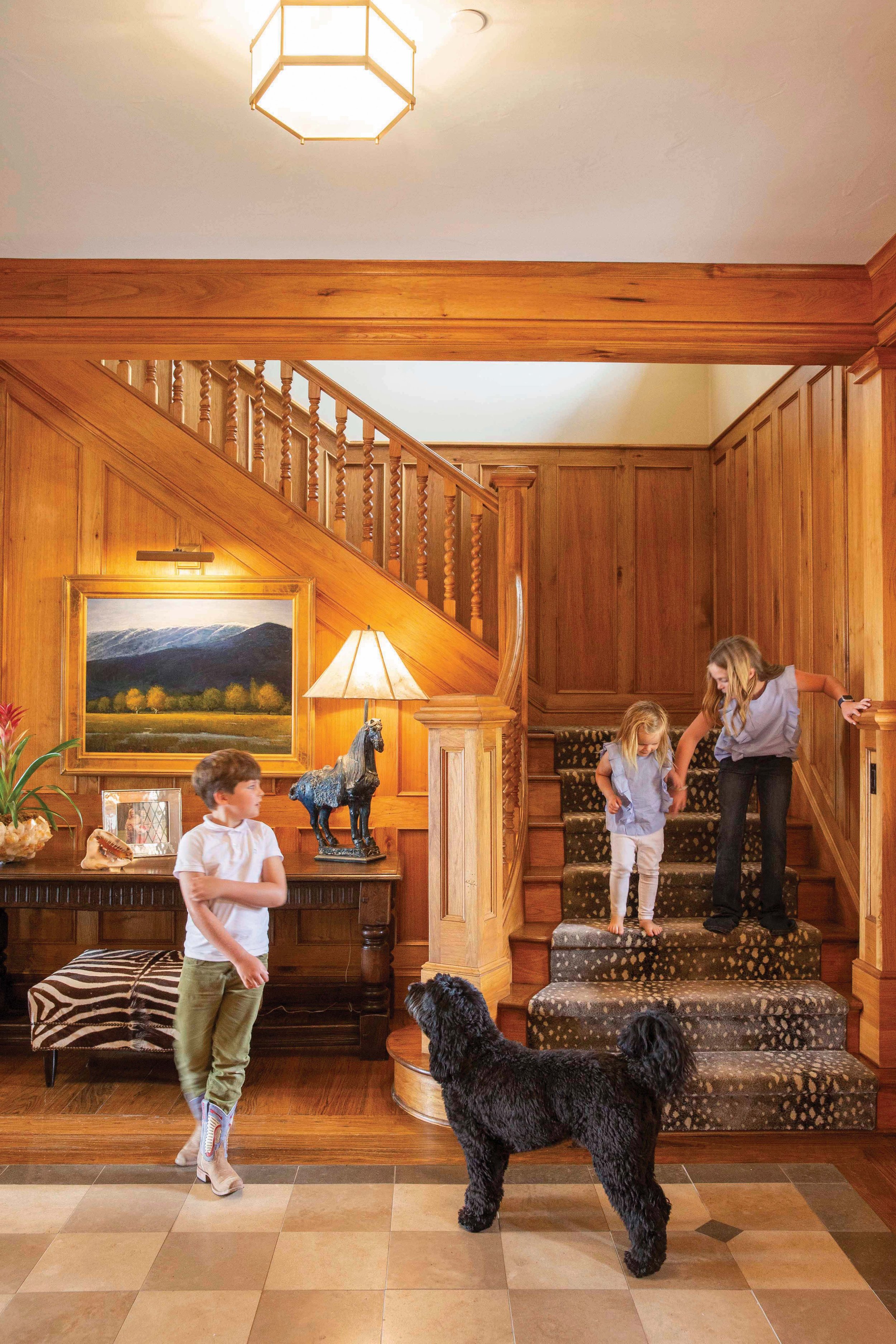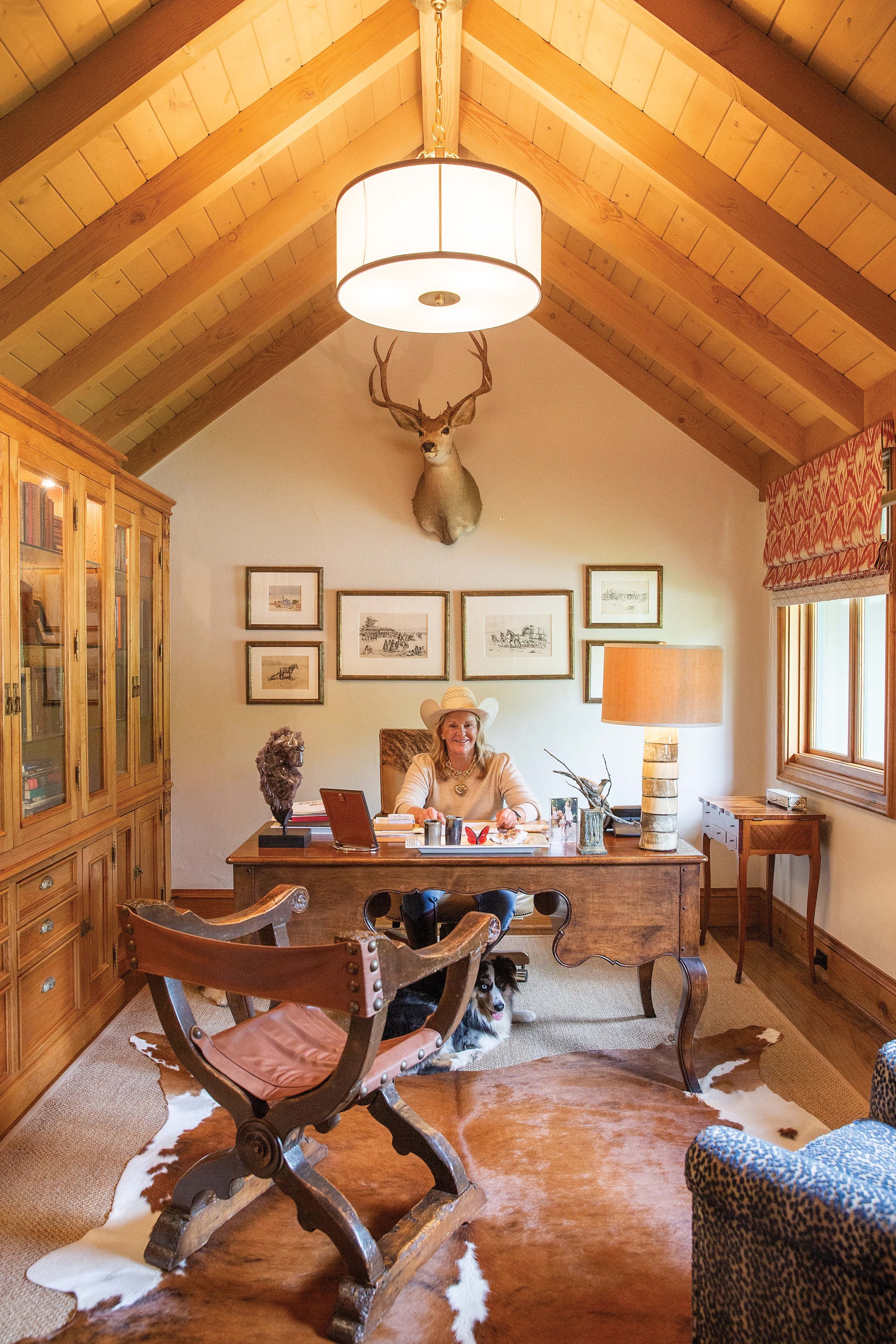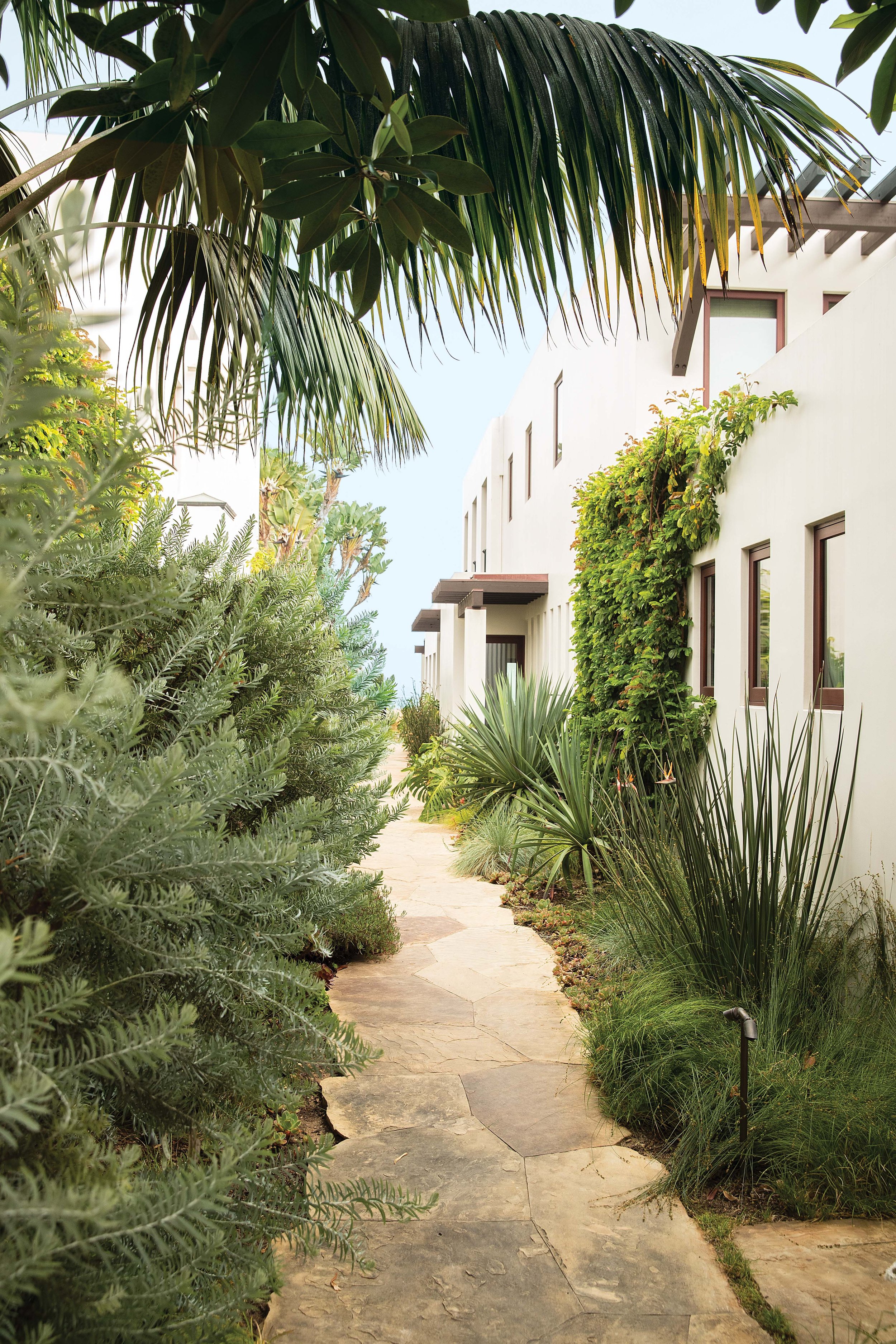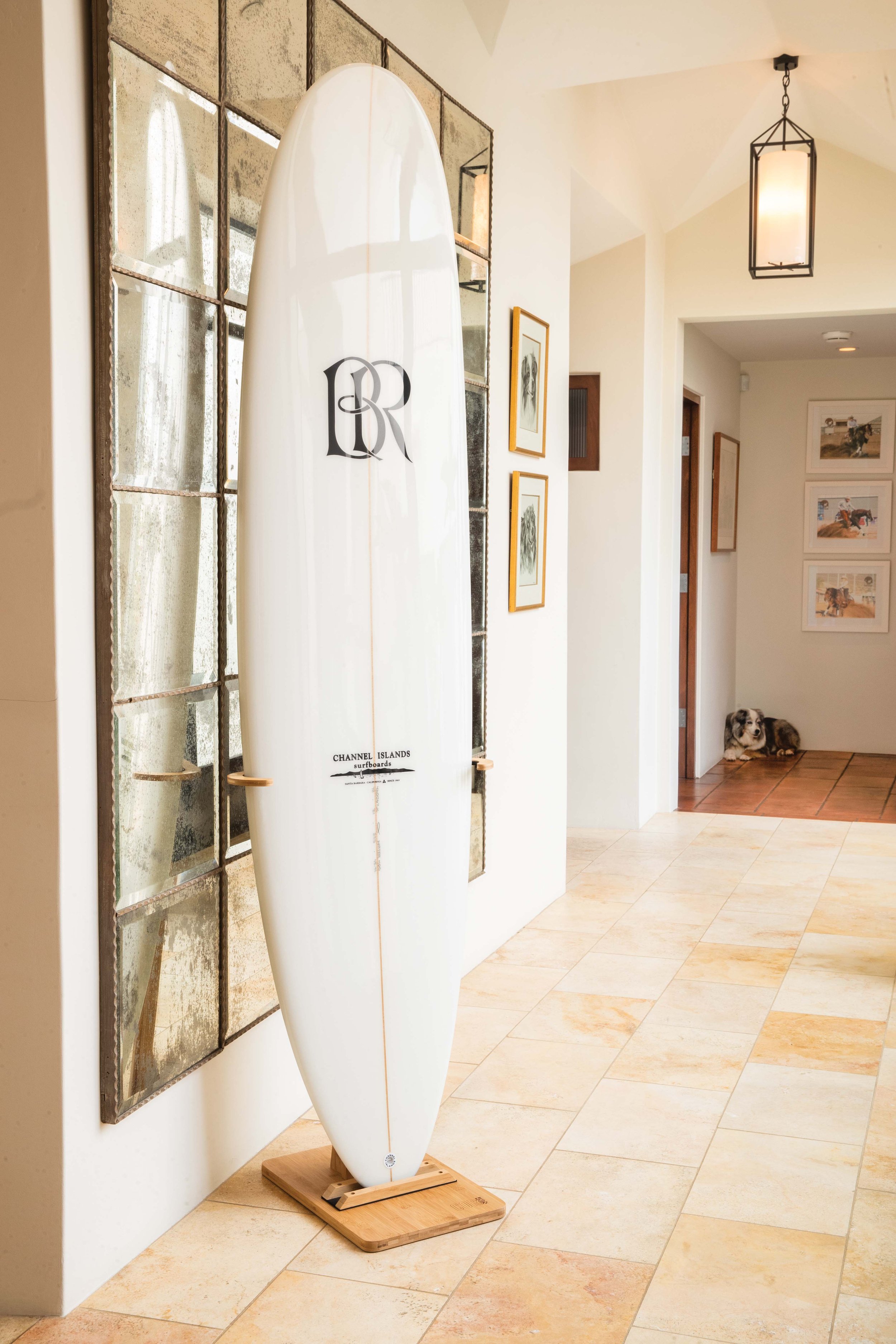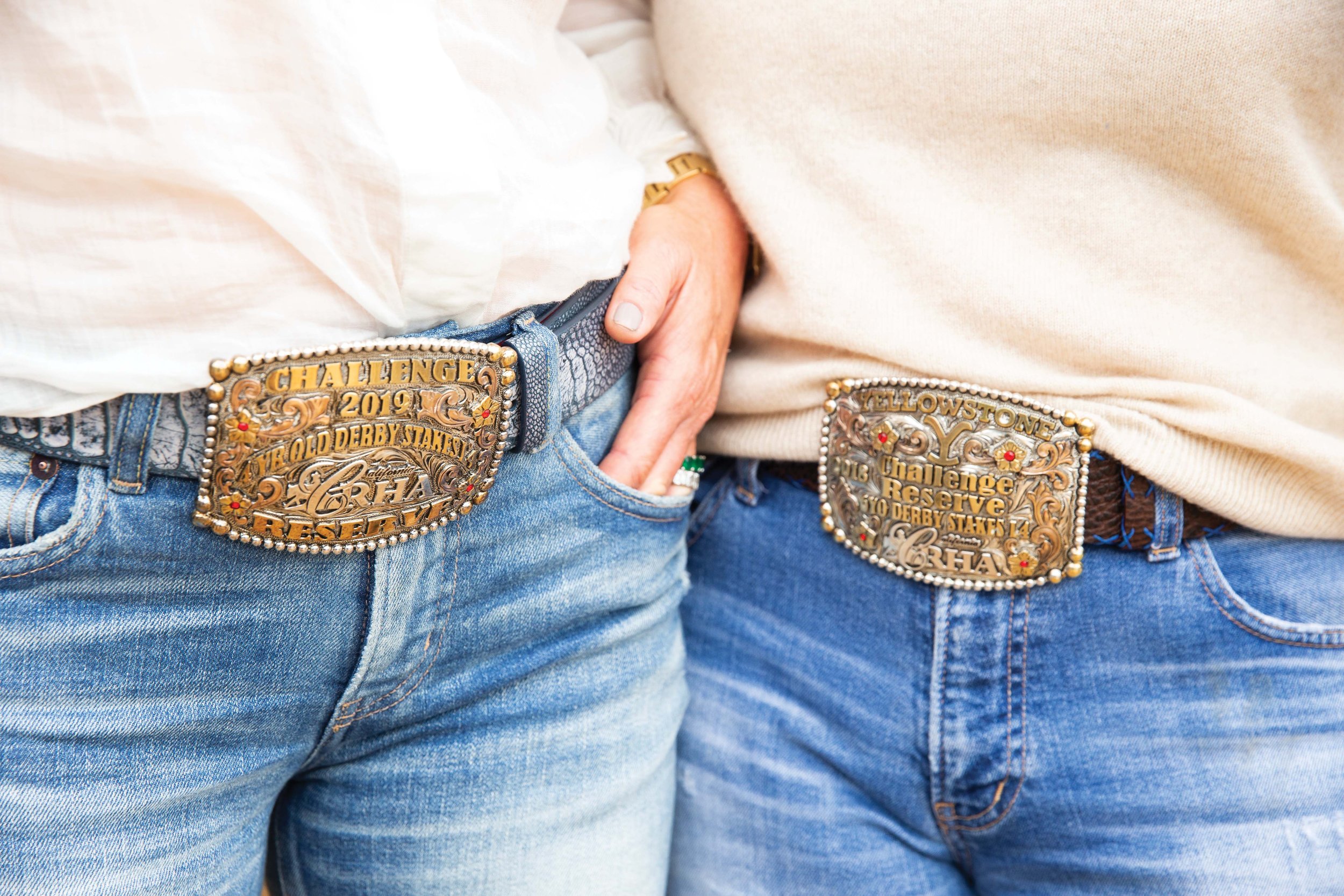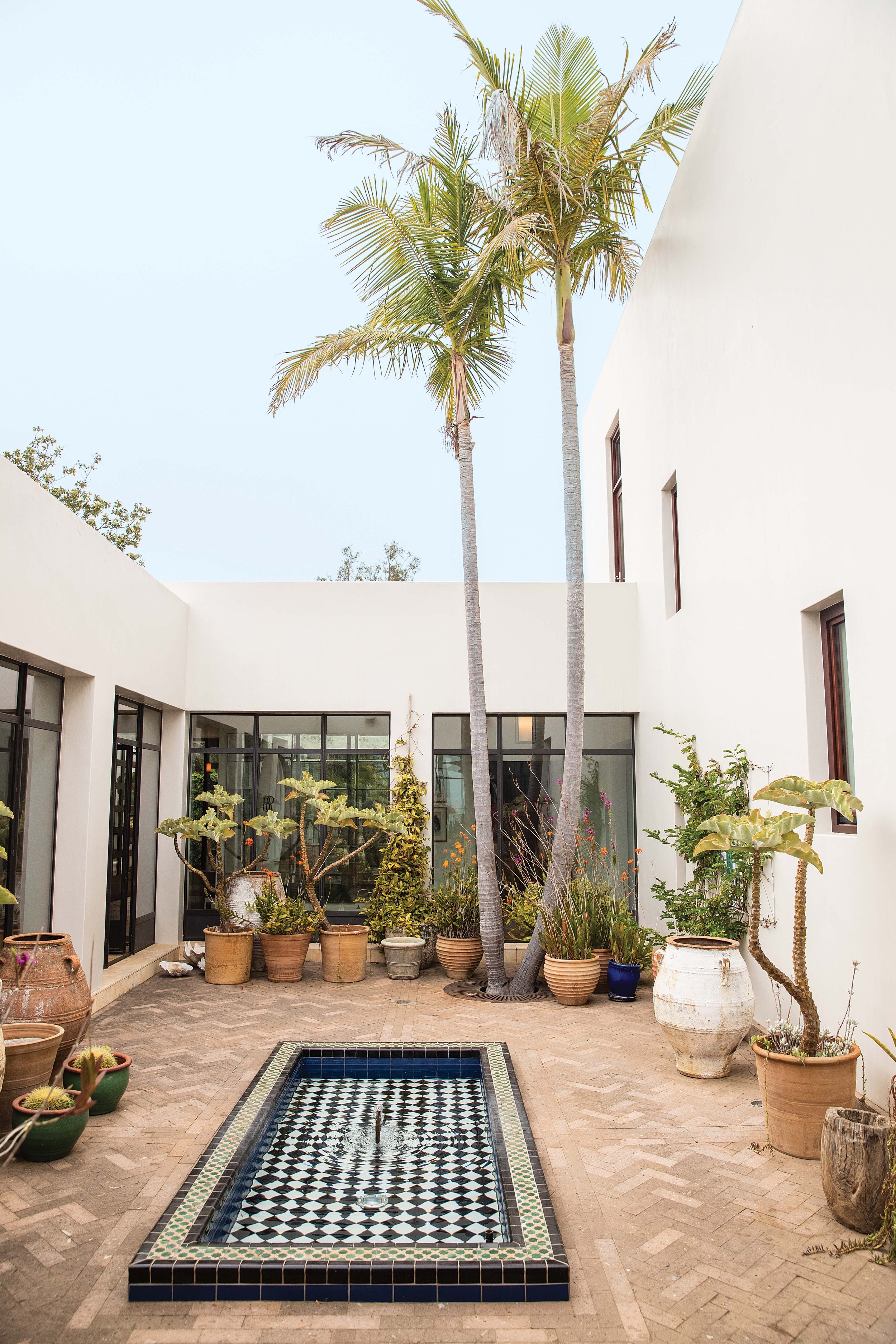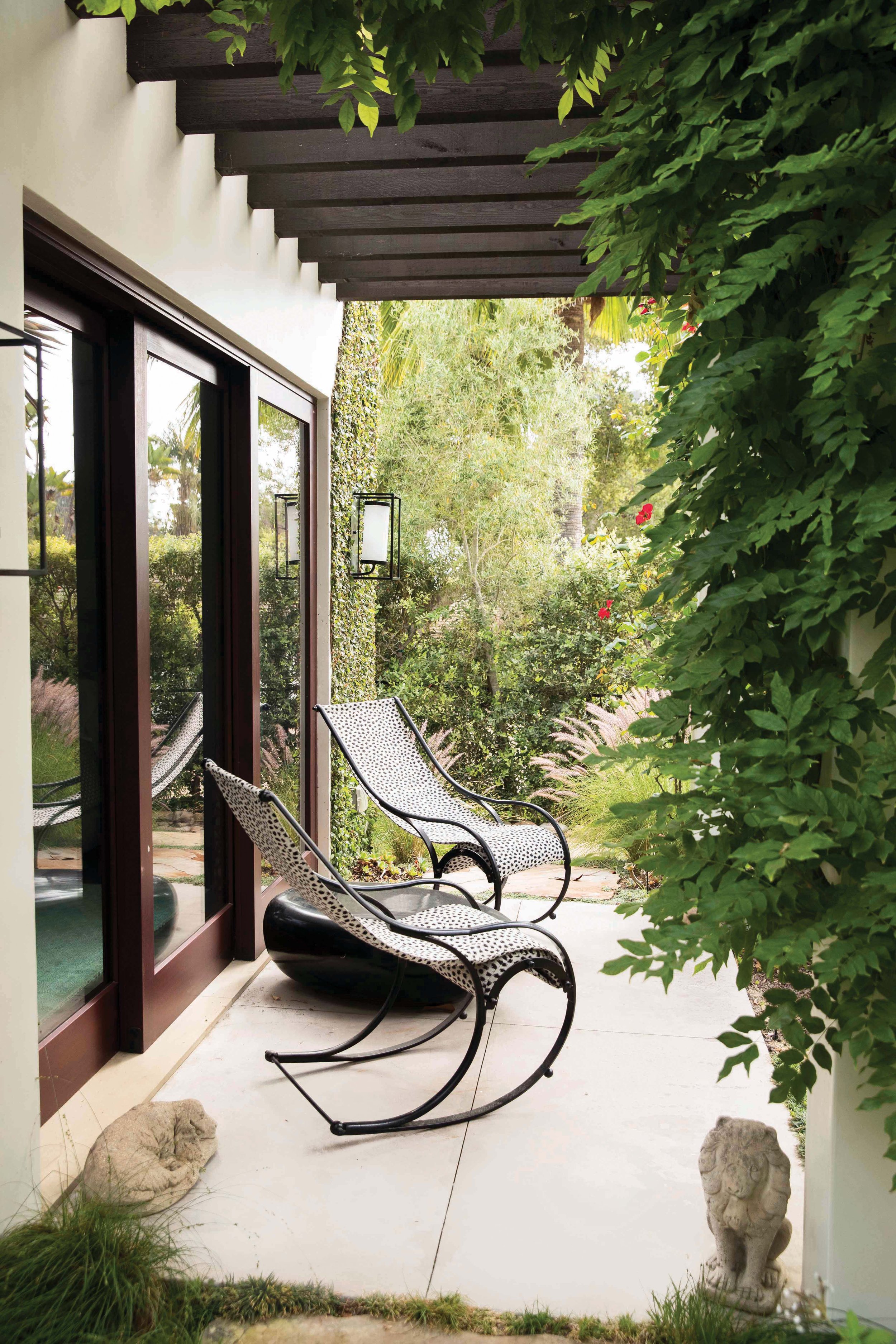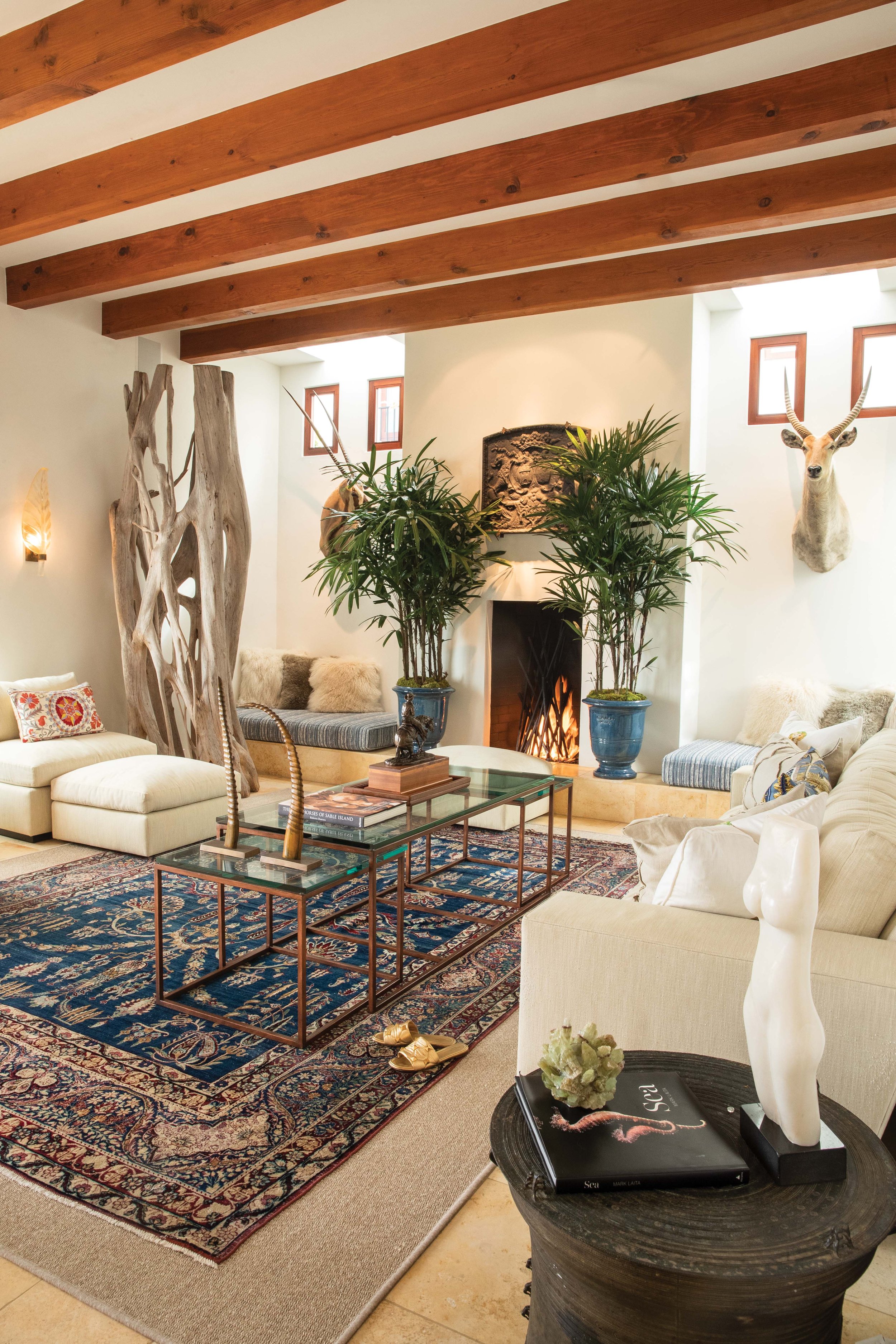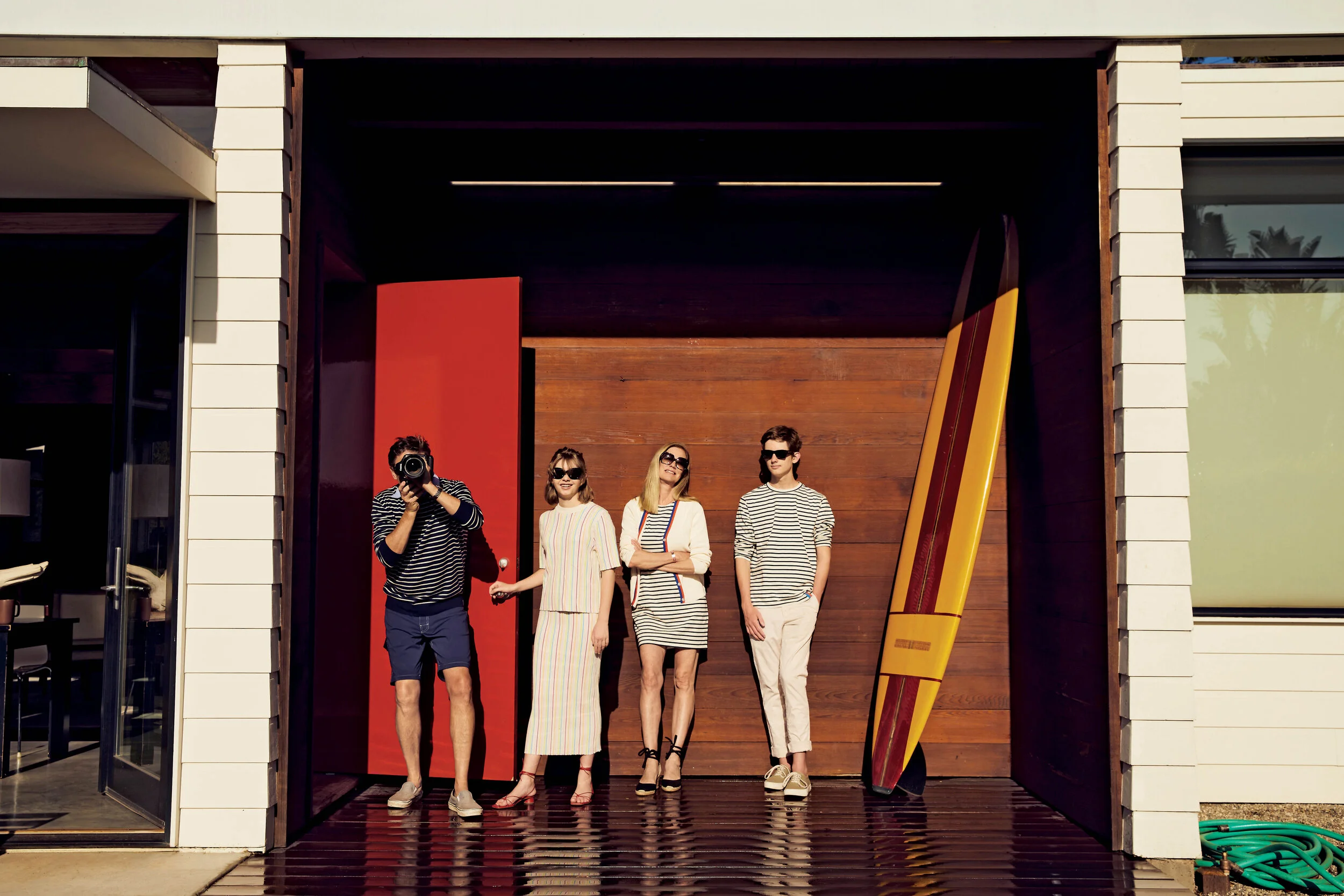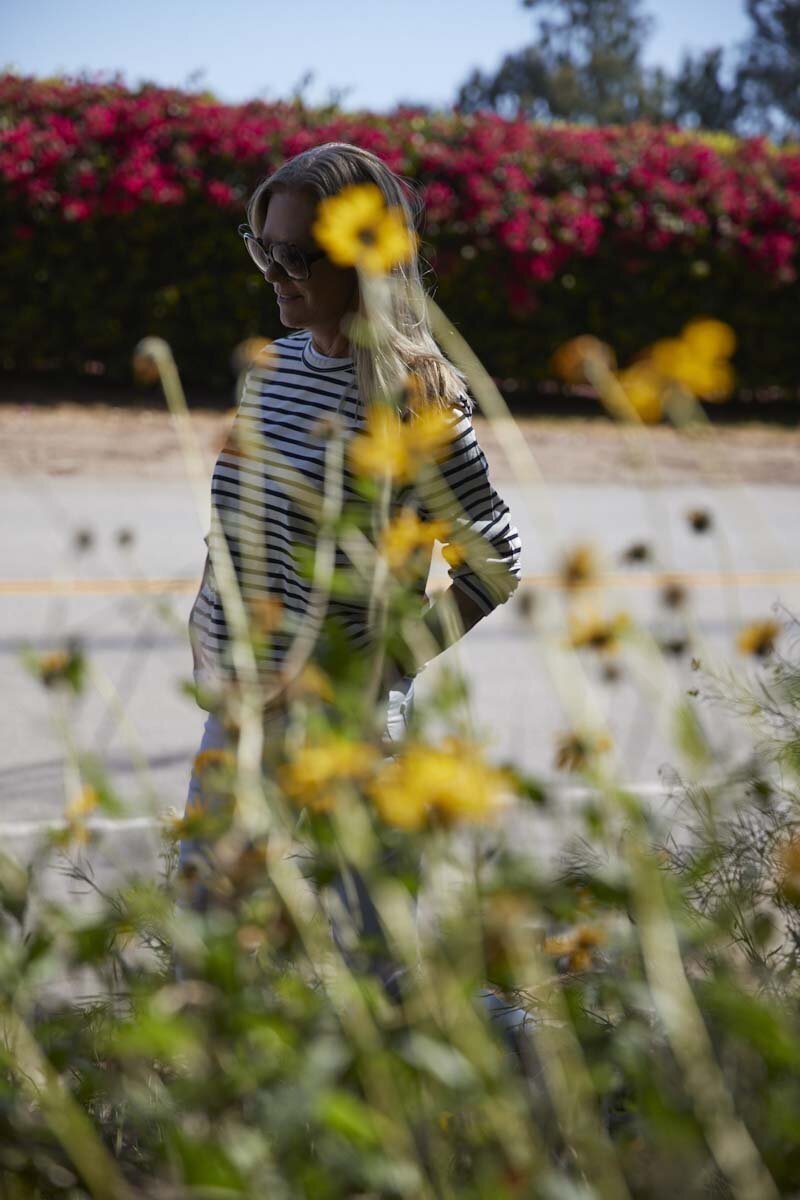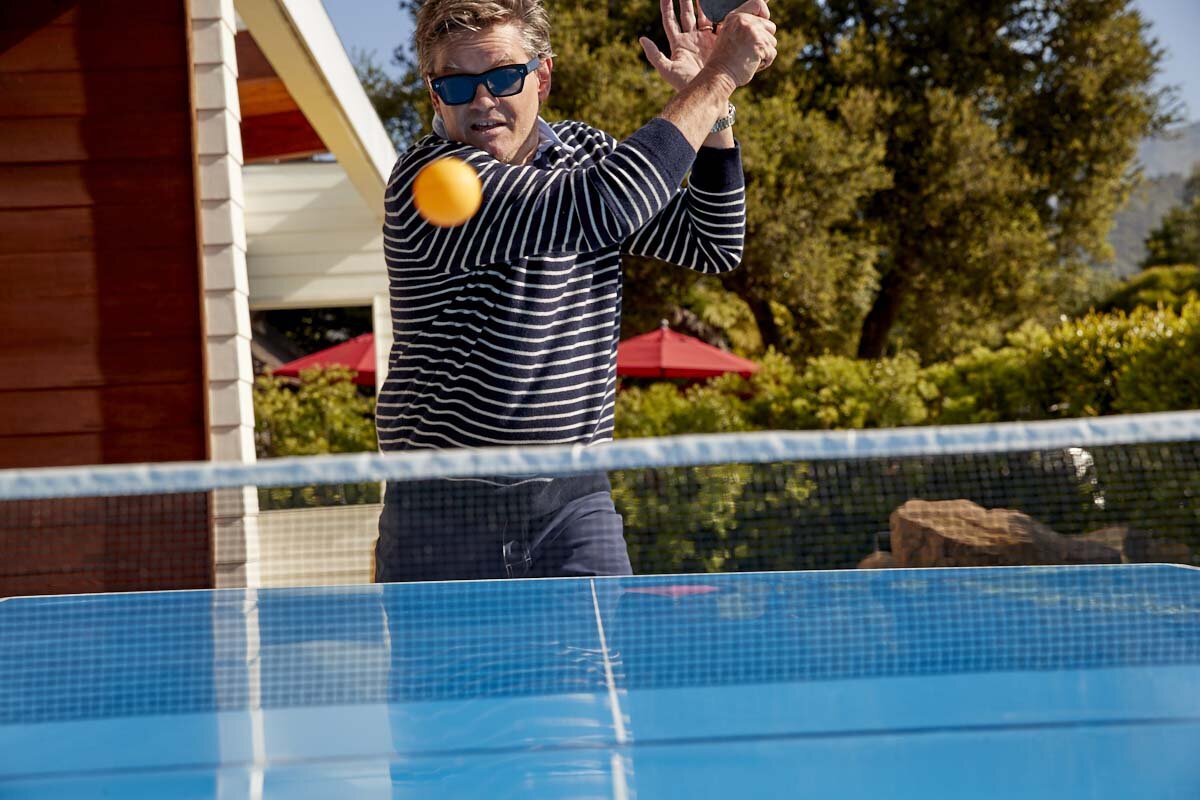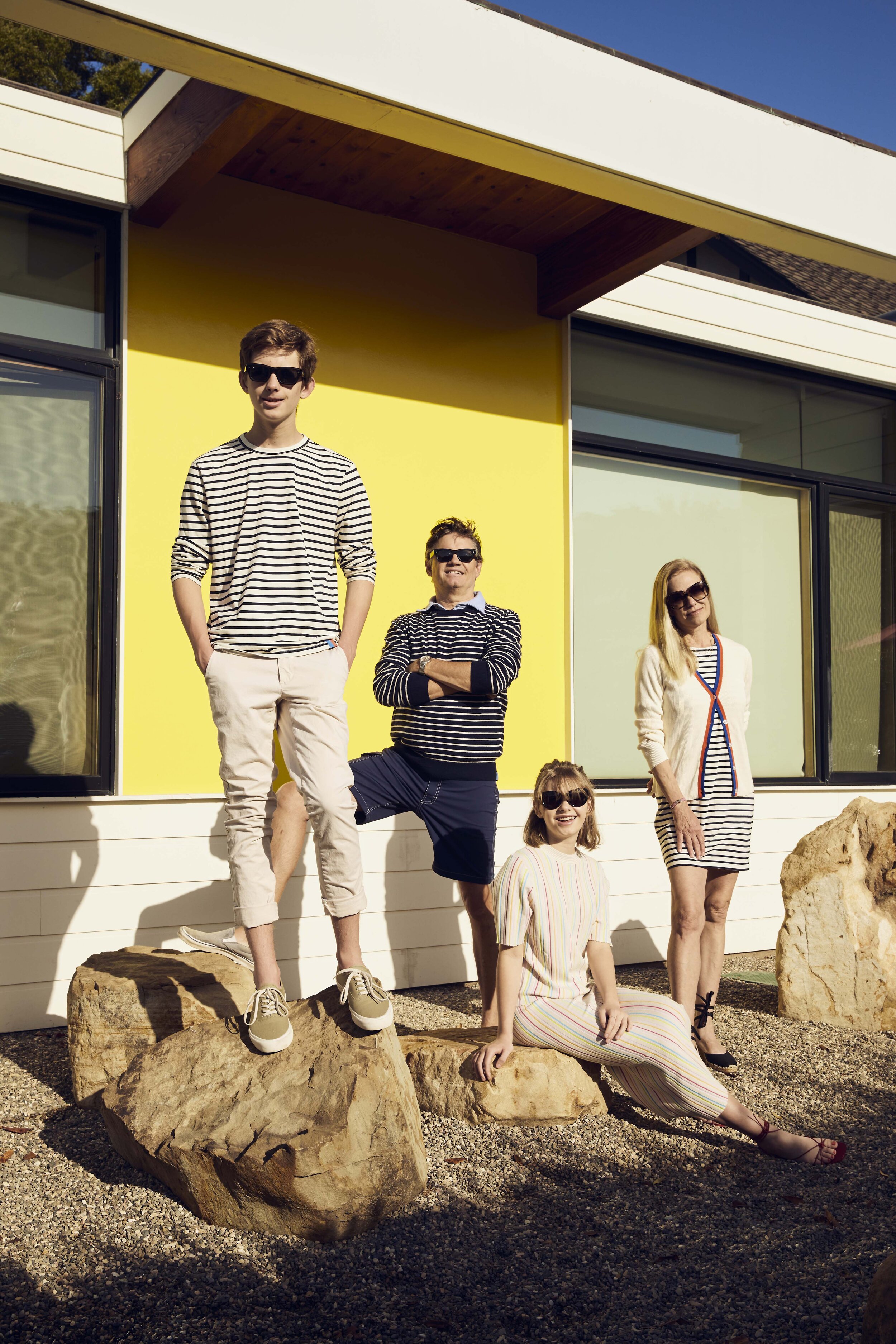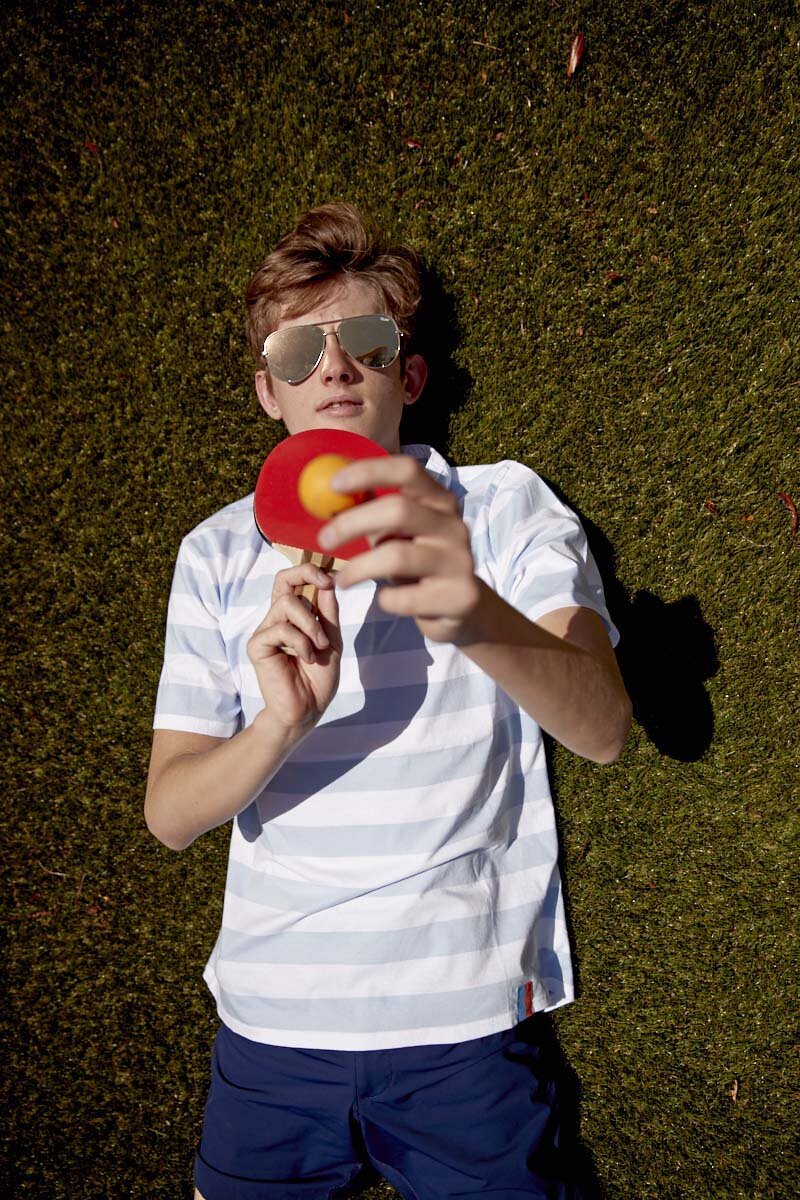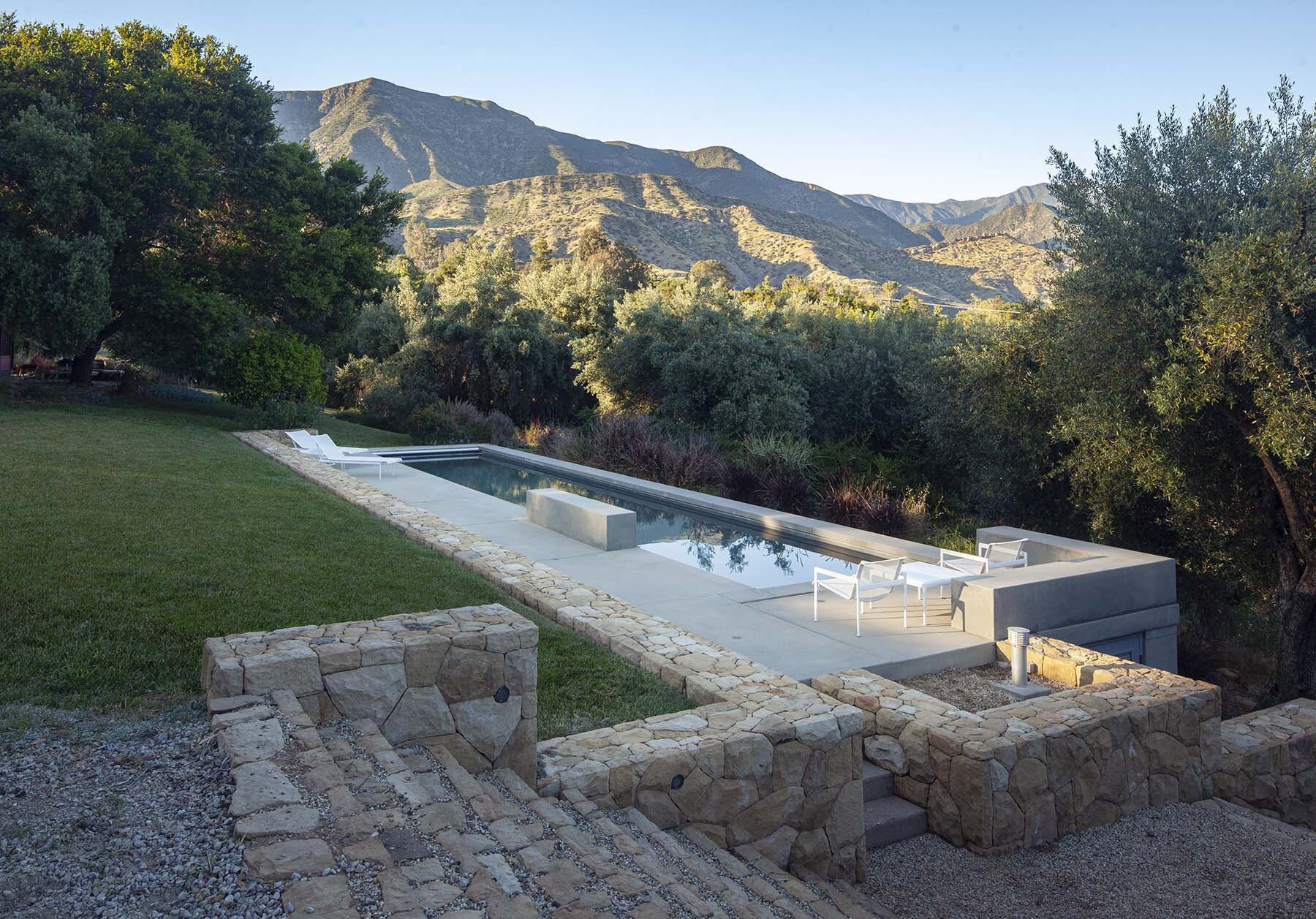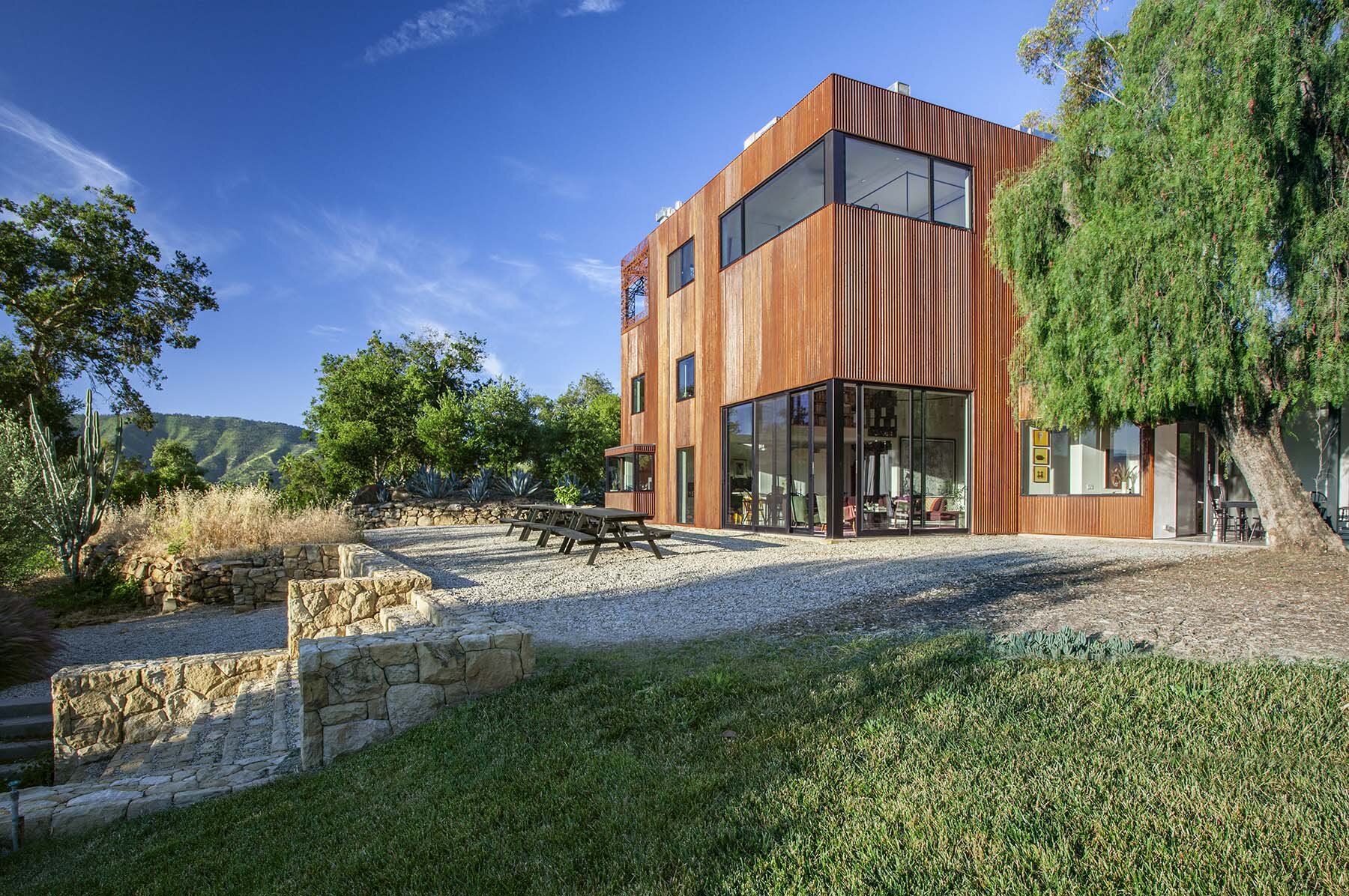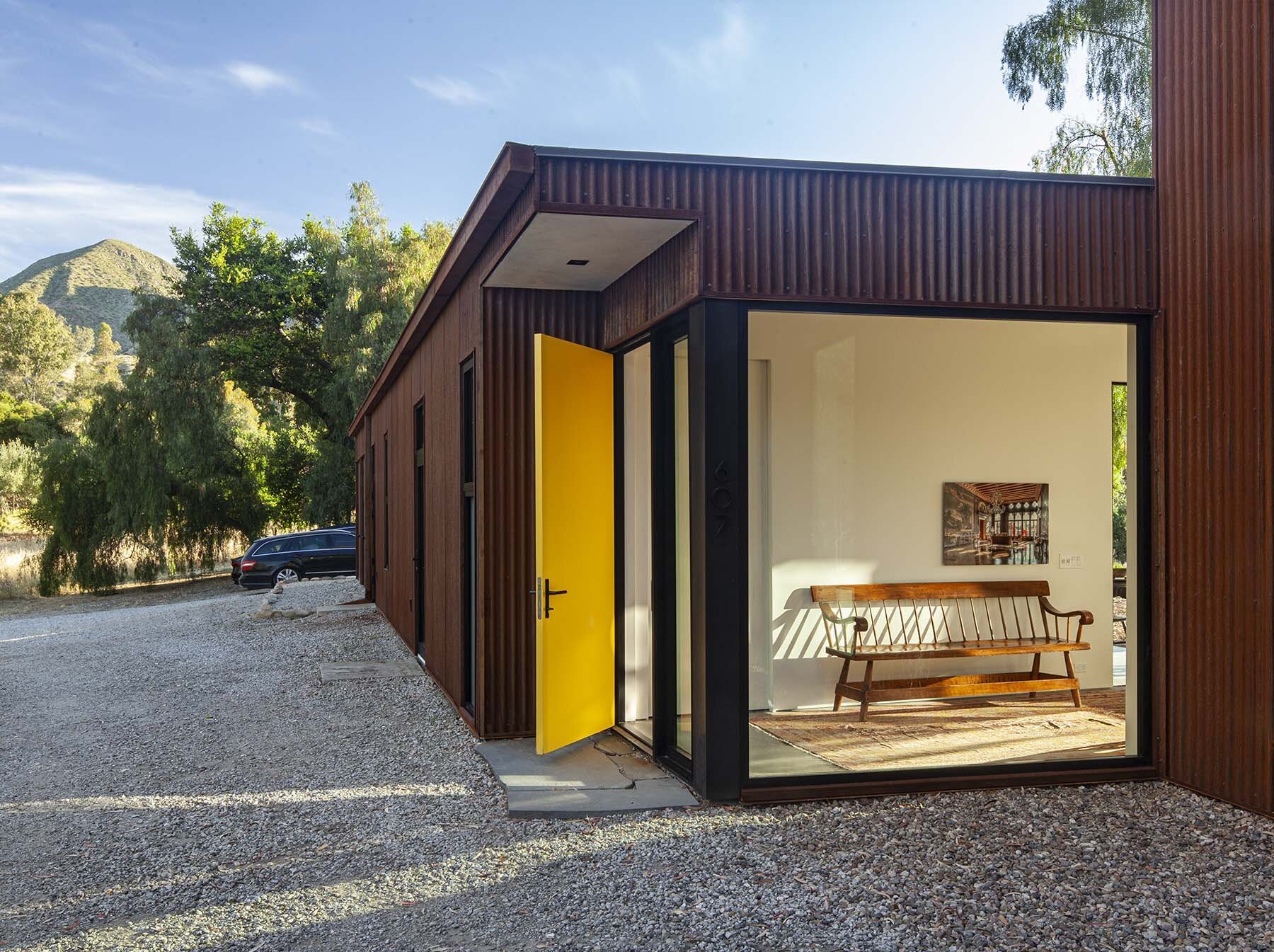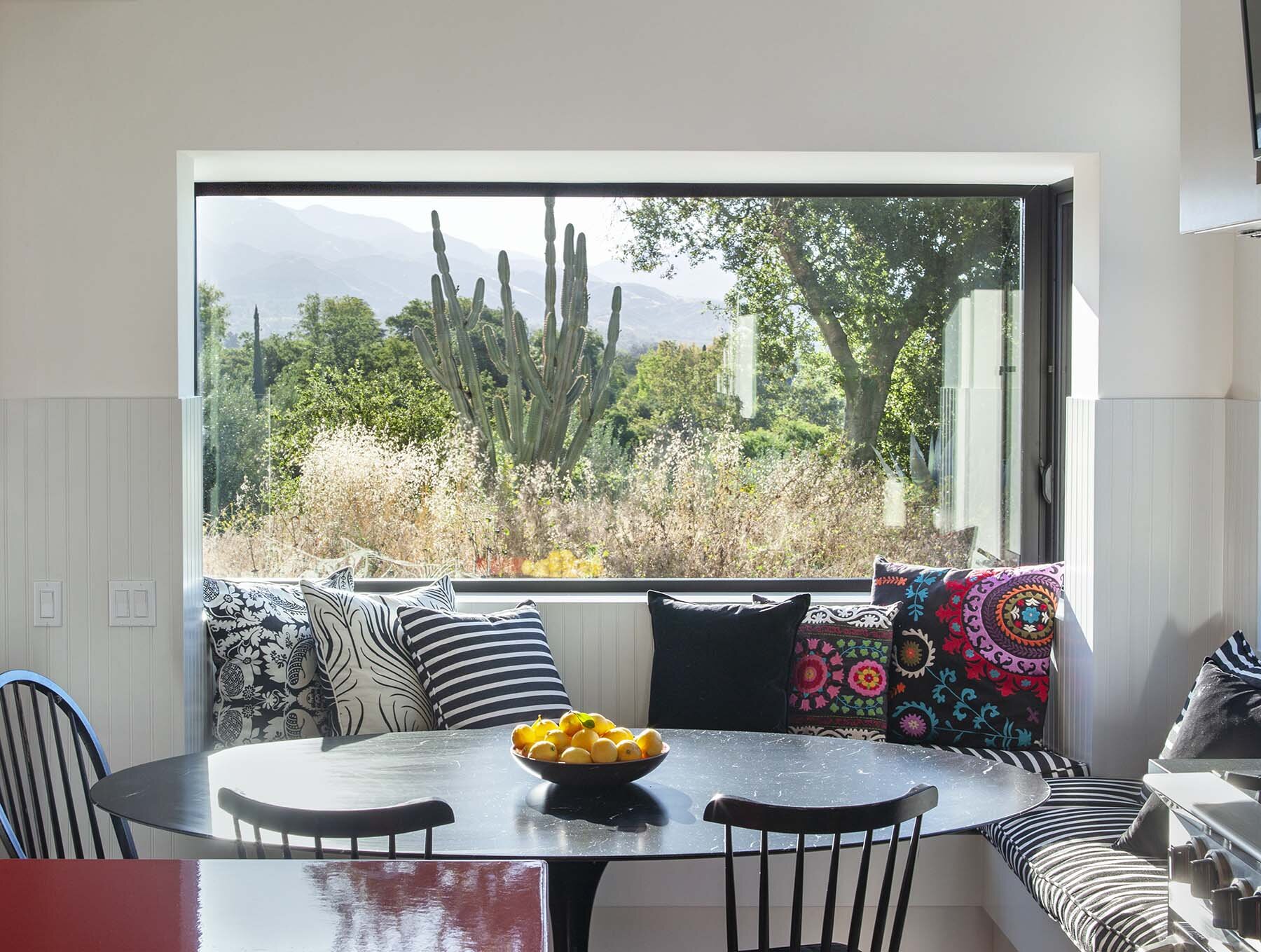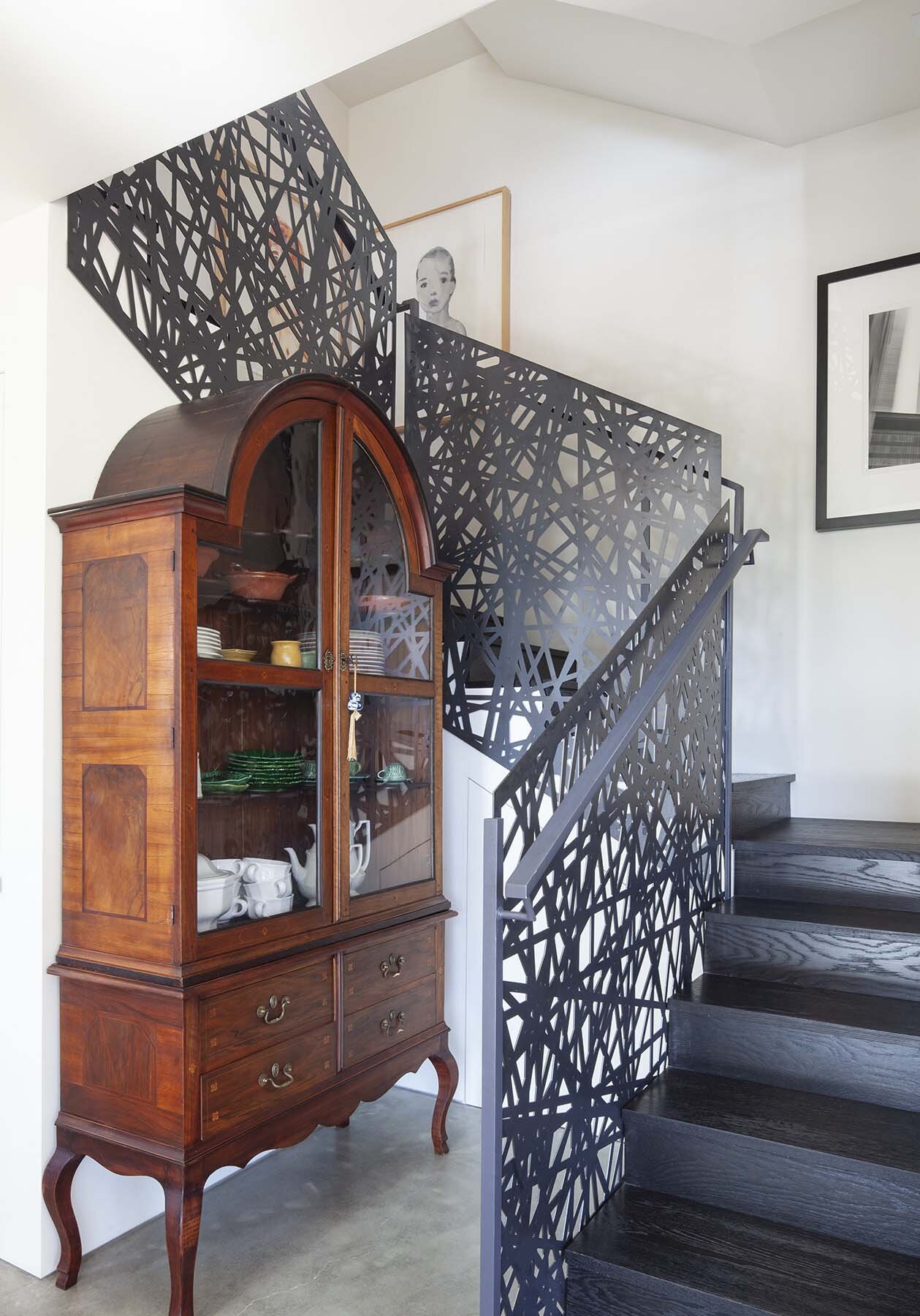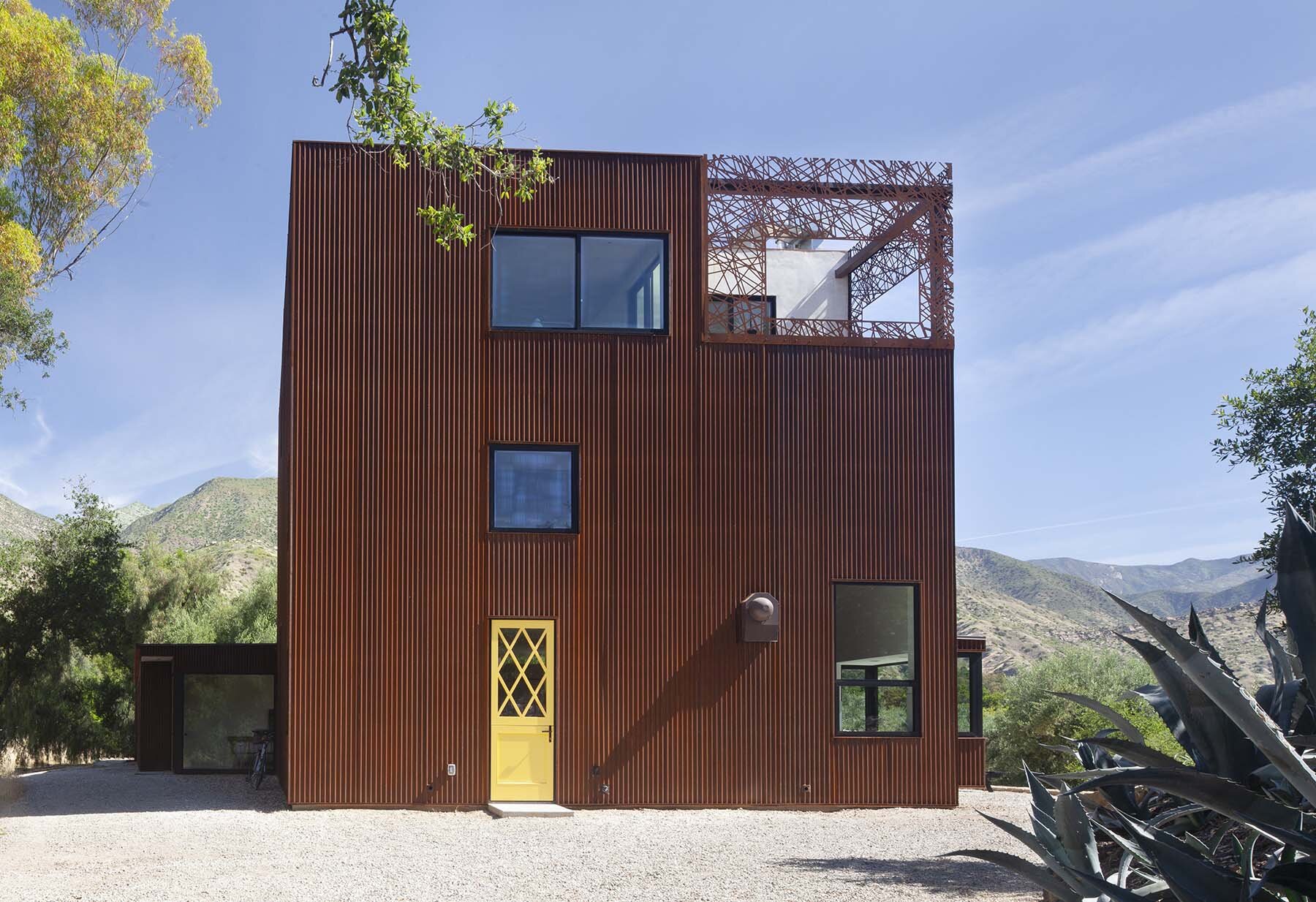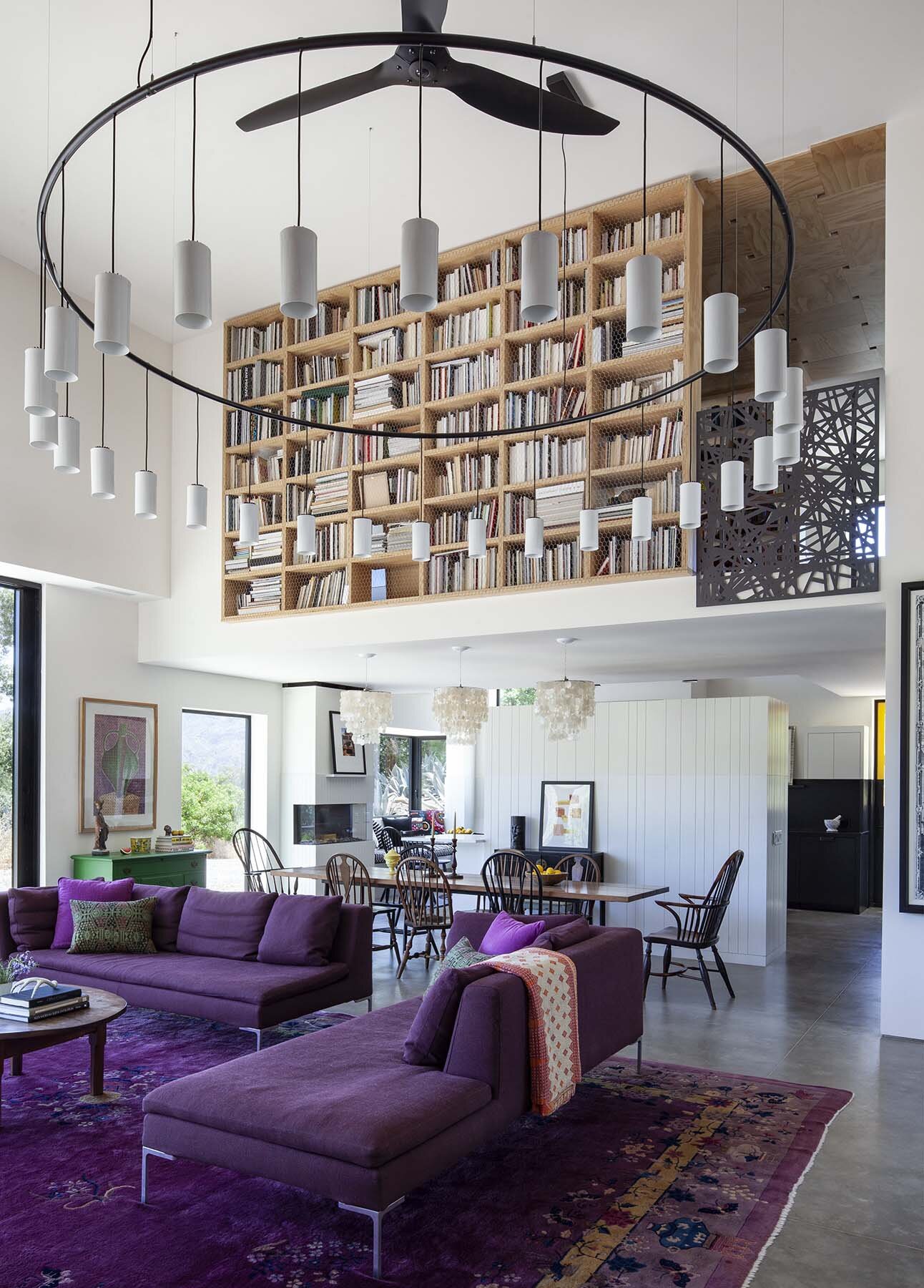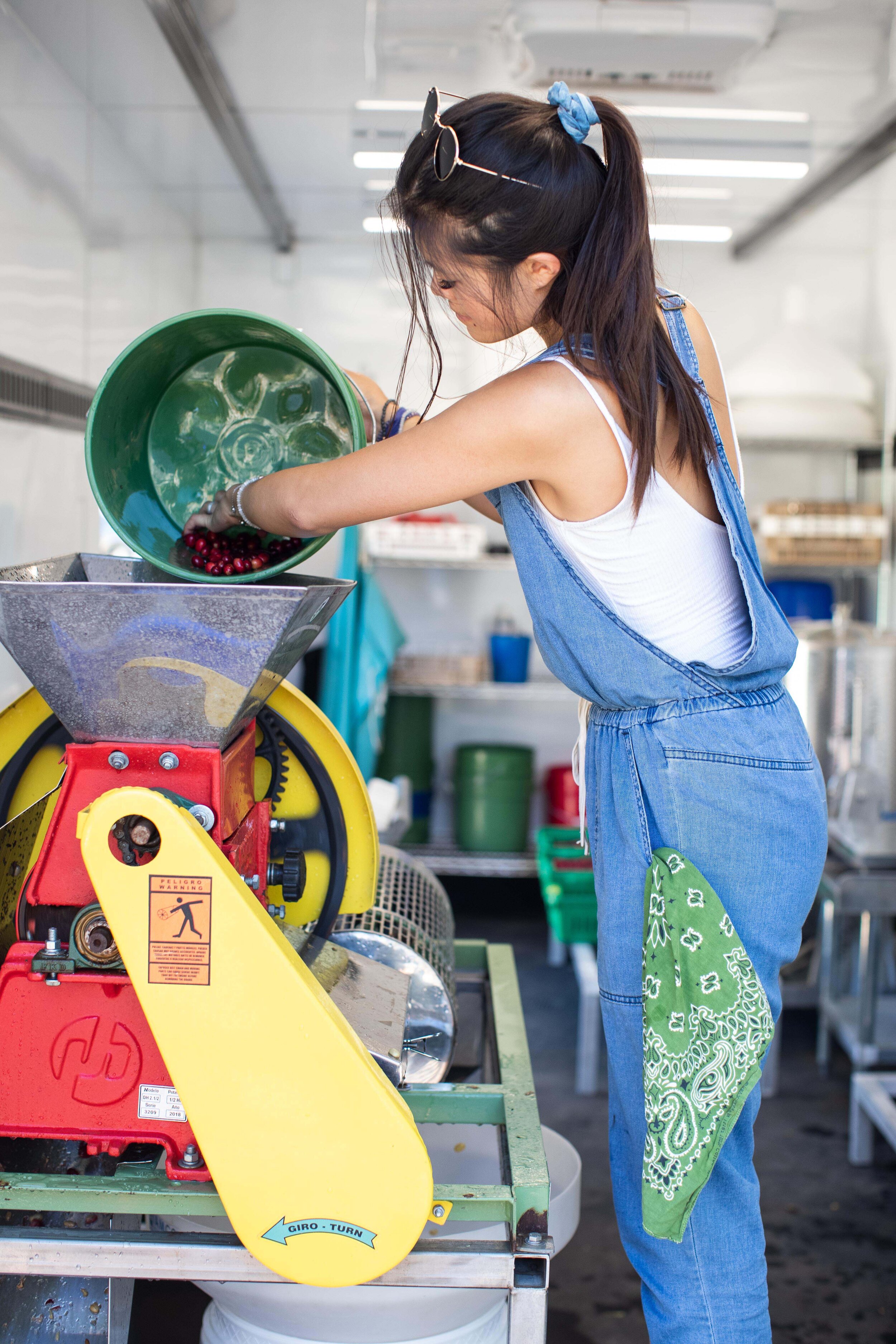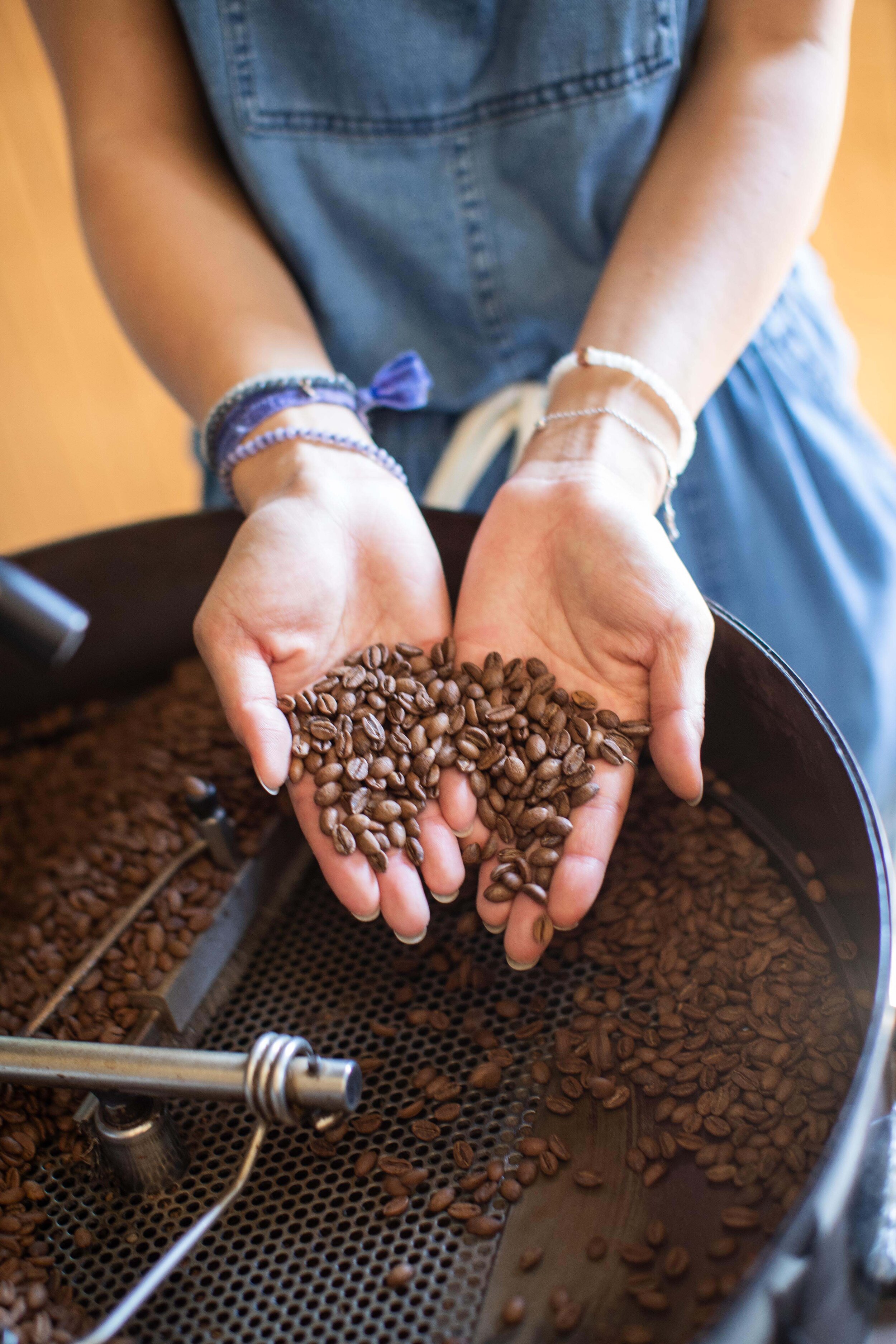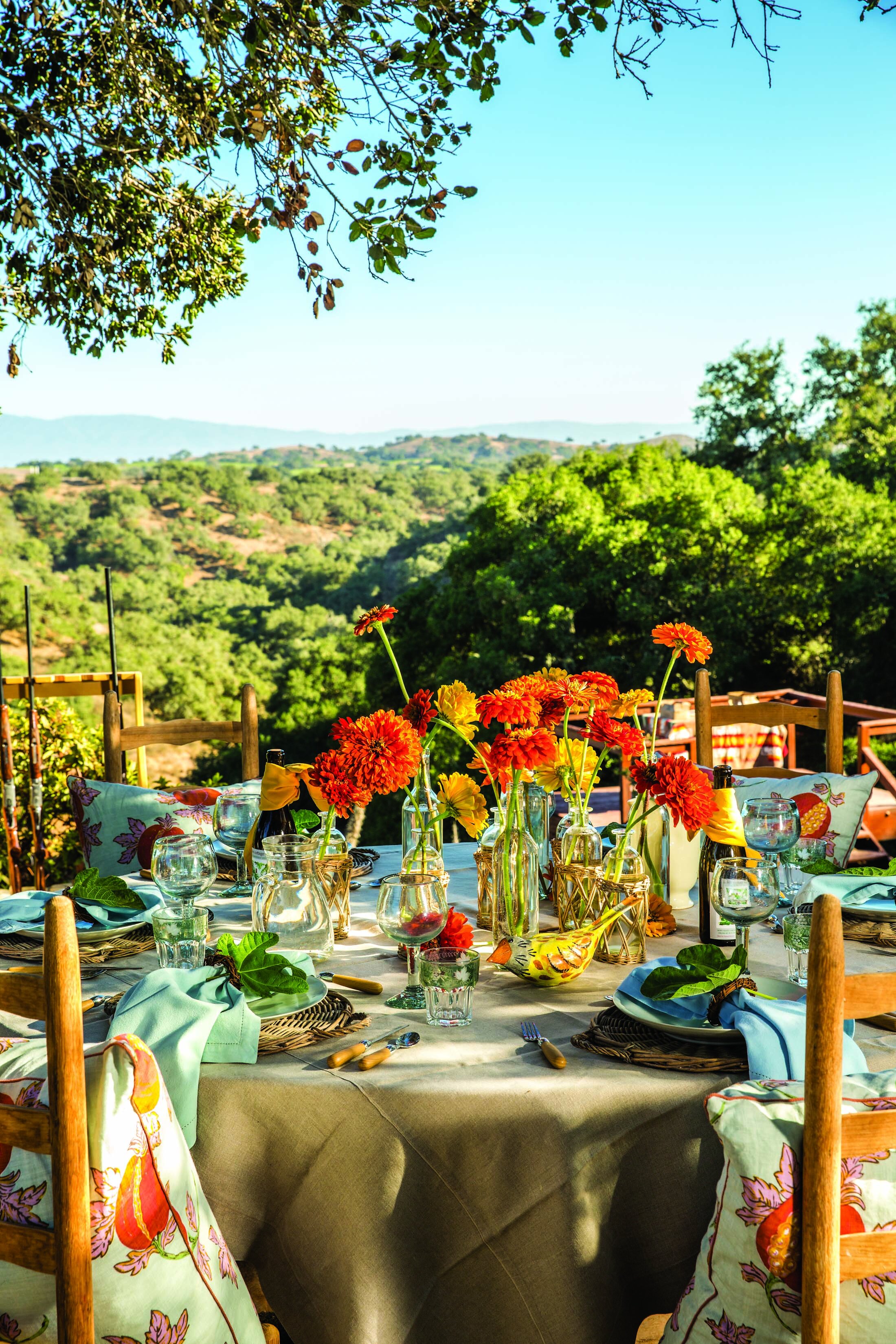Peake Experience
The artist who was also a cowboy
The artist who was also a cowboy
Written by Lorie Dewhirst Porter
Photographs and artwork courtesy of
Channing Peake Estate/Cherie Peake
Anyone who remembers life in the Santa Ynez Valley during the 1940s and ’50s will have a colorful story about Channing Peake, who was born in 1910 and died in 1989. An exuberant polymath, Peake excelled at being a cowboy (he could ride and rope), breeding horses (his stallion Driftwood is in the American’s Quarter Horse Hall of Fame), drawing and painting (his majestic murals are on permanent display at Santa Barbara’s Airport and in the central branch of the Public Library), and high-level socializing (his circle included Pablo Picasso and Audrey Hepburn). Of his many talents, Peake’s art remains a standout, and stunning examples of his work are currently on view and available for purchase at the Peake Ranch Winery, the site of his former ranch.
“Peake’s artistic style continued to evolve over the years, and his unique depictions of farm implements in the Cubist manner are especially prized by collectors.”
“I have done everything I ever wanted to do, and sometimes twice.”
Like that of other highly gifted painters, Peake’s artistic style continued to evolve over the years, and his work gradually became more abstract. His unique depictions of farm implements in the Cubist manner are especially prized by collectors.
See the story in our digital edition
Grit + Grapes
Inside the Saarloos family’s purpose-driven journey into wine!
Inside the Saarloos family’s purpose-driven journey into wine
Written by Hana-Lee Sedgwick
Photographs by Sara Prince
If I ever wrote a book, I’d call it Honor & Prepare,” says Keith Saarloos, founder of Saarloos and Sons Winery. “That’s our family creed. Honor those that came before and prepare the way for those yet to come. Everything ties back to that.”
You don’t have to know the Saarloos family to recognize this ethos. It’s baked into every bottle, every story, and every decision they make. From how they farm their vineyard and the faces of loved ones on their wine labels to the way they’ve integrated their lives into the Santa Ynez Valley community, it’s clear their legacy isn’t just about wine—it’s about people, purpose, and carrying forward with intention and heart.
The Saarloos family’s story in the Santa Ynez Valley began in the late 1990s, when Keith’s parents, Larry and Linda Saarloos, sold their family business in Long Beach with the dream of raising cattle, farming the soil, and spending their golden years working with their hands. “My dad loved three things: my mom, baseball, and farming,” says Keith. “He didn’t make it to the big leagues (though my brother did), but farming was in his blood—passed down from his dad and his granddad before him and right into me.” Larry and Linda first considered moving to Paso Robles, but it was the Santa Ynez Valley, with its open landscapes and tight-knit community, that captured their hearts. They purchased 100 acres just outside Los Olivos, home to 14,000 Fuji apple trees.
“My dad was 50 years old and decided to become a cattleman and a farmer,” Keith adds. “Most people downshift at 50. He floored it. He didn’t ask for permission, he asked what was possible, and we got to work.”
When the apple business failed almost immediately, Linda suggested planting wine grapes. So in 1999 they tore out the apple trees and hand planted 17 acres of vines—a decision that laid the foundation for everything that followed. The grapes sold quickly, and the Saarloos family poured their energy into improving the land and quality of the fruit.
During this time, Keith and his wife, Heather, were living in Long Beach, but they regularly made the drive up to help with the vineyard. “Back then, the Valley was quiet—more cattle than cars,” says Heather. “I wasn’t sure it was a good fit, but even then I remember thinking that this would be the perfect place to raise a family.” After they found out they were expecting their first child, the couple decided to make the leap. “We moved here with a two-week-old baby and lived in a barn with running water, electricity, and a potbelly stove,” she remembers. “It was simple, but it taught us to slow down, and I quickly fell for the intentional nature I found in people here.”
Keith and Heather dived headfirst into helping his parents—tending vines and selling fruit—while building their new lives in the Valley. “We’re really not afraid of unchartered waters,” explains Heather. “Our whole family has this mind-set: Jump in, go all in 1,000 percent, and figure it out together.”
Within a few years they had their hands in other ventures, including coffee shops and a spa, but 2008’s economic downturn forced a major pivot. “We were already making small amounts of wine from our own vines—just for family and friends. But 2008 changed everything,” notes Keith. “My wife looked at me and said, ‘We grow great fruit, we make good wine—let’s treat this like we do everything else: with intention.’ When the woman you love believes in you, you can’t help but believe in yourself. We went all in.”
That leap of faith led to the launch of Saarloos and Sons and their tasting room in Los Olivos, but Keith insists this decision wasn’t driven by status or recognition—it was to provide for his family and survive. “If my dad was audacious, I’m tenacious,” says Keith. “I had one shot to make this work, and quitting wasn’t an option. I worked seven days a week for years, because that’s what we do. I made mistakes, but tenacity beats talent every time.”
Adds Heather, “Wine wasn’t part of the original plan, but it became the path forward. Keith has always had this drive to build something that lasts, something bigger than himself. Building the brand and creating an alternate way in which to approach wine gave him that purpose. It’s not just about the craft—it’s about creating a legacy rooted in hard work, intention, and a deep connection to the land. He’s building something our kids can stand on.”
As for their two children, who have grown up among the vines, she says, “Farming and winemaking have shown our kids how to show up every day, stay grounded, connect with people from all walks of life, and not be afraid to get their hands dirty.”
Those values—devotion, hard work, and human connection—have guided every step of the journey, including Keith’s decision to build the winery around people, not prestige. “We make wine for people we know, people we care about. Our customers are family. Building something I, and they, can be proud of, that’s the success I care about,” he says. That grounded outlook comes through in every part of the business, from Keith’s candid, honest approach to social media to the design of the Los Olivos tasting room, which feels more like an inviting living room than a traditional tasting room. The wines, each bearing the name and face of a loved one, are tributes to the people behind his story.
After Larry Saarloos passed away in 2020, Keith’s sense of purpose only deepened. “When my dad died, I felt this weight: not just to shine up his name but also to build our legacy into something,” he says. “The words honor and prepare are what got me out of bed. I had to show up—for my mom, for Heather and the kids, and for the community we love so much. This Valley smells like hard work and dirt, and that’s a beautiful thing. You protect places like this. And when you have the chance to make something better—for your kids, your town, or even just one person—you take it. That’s how you make the world a better place.”
“This Valley smells like hard work and dirt, and that’s a beautiful thing. You protect places like this. And when you have the chance to make something better—for your kids, for your town, or even just one person—you take it. That’s how you make the world a better place.”
The Saarloos family in the region that has shaped their story.
Carrying that spirit forward, Keith happily leads free vineyard tours every Saturday, welcoming anyone to walk the land with him, hear the stories behind the vines, and feel a sense of connection. “I live in the dirt; it’s my home,” he says. “I never set out to be a farmer, but God made me one. Farming was and continues to be the goal. Wine just happens to be the thing our farming produces. From our plow to your porch, it’s just us, working hard for the people we love.”
See the story in our digital edition
Behind the Chutes
For photographer Emmanuelle Pickett, rodeo is a way of life, and it’s in those little moments behind the scenes where you find the real gold
For photographer Emmanuelle Pickett, rodeo is a way of life, and it’s in those little moments behind the scenes where you find the real gold
“Behind the chutes, I don’t see the performance; I feel the heartbeat of the rodeo. When I’m shooting, it can sometimes feel like I’m patiently hunting. Waiting for that moment of truth that hits straight to the heart.”
“Behind the chutes, there’s no spotlight, just the steady rhythm and ritual—wrapping wrists, tightening leather, a whispered prayer, and a nod that says, ‘I’m ready.’”
“It’s grit and grace mixed in dust and sweat, a brotherhood built on trust and the kind of stubborn heart you can’t fake. I’m chasing that story—the raw, honest moments that don’t make the highlight reel but hold the whole performance together.”
“Every rider’s got their own ritual. Some stretch, some spit, some stare a hole through the dirt. I just wait for the moment their eyes go still.”
“In a world that often feels unpredictable and uncertain, the rodeo has become a place of comfort for me. I can trust in the values, the tradition, and the dedication to family. From the quiet moments behind the scenes to the national anthem and the rodeo prayer, rodeo season feels like home”
For more of Emmanuelle Pickett’s photography, visit @emmylaine
See the story in our digital edition
True Blue
One of the most striking aspects of artist David Florimbi’s work is his use of the color blue.
Artist David Florimbi finds inspiration within
Written by Lorie Porter
Photographs by Dewey Nicks
One of the most striking aspects of artist David Florimbi’s work is his use of the color blue. “It’s a tonal resonance that’s really hard to achieve,” he says. “And once you get it, it’s like magic; then you can swim in it. It’s my chord. It’s my harmonic.” Indeed, Florimbi has plumbed the depths of the cool spectrum from deep inky indigo to brilliant icy turquoise for the past four decades. And he’s not done yet: “Yves Klein was onto something,” he says, about the artist who created the iconic color International Klein Blue. “It is a spiritual portal.”
Florimbi and his wife, Nancy, recently resettled from Montecito to the Santa Ynez Valley, and their bucolic ranch property includes a spacious separate building for Florimbi’s art studio. Painted entirely white, its pristine walls provide a perfect foil for the artist’s colorful canvases. It’s also an ideal setting for this chapter of Florimbi’s life, a place where he can fully devote himself to the creative process far removed from the frenetic vicissitudes of the art world.
He was born in Pennsylvania, and nothing in Florimbi’s upbringing hinted that he would end up an artist. His parents were both native Italians. “There’s no artist in the family,” he notes, “no model to follow.” Florimbi’s father worked in the defense industry, a profession that took the family to Europe for several years. They returned to the States and settled in Massachusetts when Florimbi was a teenager. When a skiing accident during his senior year in high school left him immobile for several months, Florimbi opted to take an art class, which piqued his interest. His innate talent was discovered by an inspiring teacher, who he remembers to this day: “Mrs. Chapman,” he recalls, his voice full of emotion. “She saw it.”
Florimbi went on to study fine art and English at Georgetown University and was awarded the school’s Milton Glaser Design Fellowship, which came with a cash award that enabled him to travel to the West Coast for the first time. “The West Coast made more sense to me with my European background than the East Coast did,” he says. Needing a job in order to stay in California, Florimbi got his start in television production through his girlfriend at the time, whose father was in the business. He quickly scaled the ranks of Aaron Spelling’s entertainment company, which produced iconic TV shows like The Love Boat and Dynasty. But he never gave up on his art; after working all day at the studio, Florimbi would drive to North Hollywood—where he rented space above an abandoned movie theater—to paint. Eventually the directors and agents he worked with convinced Florimbi to switch to art full time. “It was like, ‘David, I don’t want to hire you, I want to buy your paintings,’” he says. From that moment, Florimbi decided art was his life and never looked back.
He soon found himself at the white-hot center of the art world, and his solo gallery exhibitions in Los Angeles and New York were frequent sellouts from the late 1980s through the mid-2000s. Closer to home, his work has been exhibited at the Museum of Contemporary Art Santa Barbara and University of California Santa Barbara’s Art, Design & Architecture Museum.
From a critical standpoint, a HuffPost reviewer praised his landscape paintings, in which the sky seems to overwhelm the earth as “possessing a force powerful enough to slip the ground out from under your feet.” A notable piece in Vanity Fair disclosed that Florimbi’s shows were always “crammed with Industry fans.” His former colleagues in the TV world became his loyal patrons and have remained so ever since. “In terms of people who can change your life, patronage is everything,” Florimbi says.
In fact, for the past decade all of Florimbi’s work has been acquired by private collectors, modern-day Medicis who have freed him from the enormous pressure of creating a body of work for gallery shows. Describing the art world as “a contact sport,” Florimbi acknowledges that “it’s so much pressure, I’ve gotten to the place where I don’t like it as much. It’s so performative.” Even so, he’s maintained his art-world contacts and doesn’t entirely dismiss the idea of mounting a show again someday.
“I don’t draw from nature at all. I like to think about it more as being a seer than a painter; it’s coming through me.”
Back to blue: Meanwhile, Florimbi is enjoying making art in his new studio. He continues to study and admire the work of other artists, especially the Italians: “I think about Bernini a lot because he could do it all,” he says. “He could do the paintings; he could do the sculpture; he could do the architecture.”
Surprisingly, Florimbi’s landscape paintings are not based on actual places or settings. “I don’t draw from nature at all. No studio I’ve ever had had good windows. I don’t even want them.” Essentially he creates from his own interior landscape. “I like to think about it more as being a seer than a painter; it’s coming through me.”
The Shifting Point, a retrospective of the artist’s work, will be on view at Separate Reality in the Funk Zone, Sept. 19–Oct. 12, separatereality.info
See the story in our digital edition
Outstanding in Los Alamos
A dinner showcases the renewed bounty of a central coast ranch.
A dinner showcases the renewed bounty of a CENTRAL COAST RANCH
Written by Caitlin White
Photographs by Jake Lutz
The life’s work of land artist and Outstanding In the Field founder Jim Denevan is to continually create better iterations of extraordinary and memorable dining experiences that invite guests to commune with the physical environment where their food is sourced and produced.
“The events are a way for people to have more meaningful connections at this long table, and a deeper sense of where they live or where they might travel,” Denevan says of the series. “My inspiration for Outstanding In the Field is to bring the farmer, the chef, and the general public closer together. This happens through experiences that inspire greater connection, which over time makes for a more meaningful food culture.”
Taking place for more than 25 years, the wildly popular series has become something of a phenomenon, particularly on the West Coast, where an abundance of fields, farms, and functional outdoor spaces are available for transformation into a hospitality pavilion for one night. The events have become renowned among food and wine lovers, aficionados of the hyperlocal, and anyone with a soft spot for farm-to-table dining.
“Outstanding In the Field events have become renowned among food and wine lovers and aficionados of the hyperlocal.”
Denevan has thrown multiple dinners in the greater Santa Barbara area, including many in idyllic vineyards. A number of collaborations have been with chef Clark Staub of Full of Life Flatbread in Los Alamos. One of these gatherings recently spotlighted Las Cumbres Ranch, a holistically managed cattle ranch near Los Alamos. Acquired by the Selbert family in 2017, the ranch is known for its soil-regeneration practices, a system that has changed the quality of its produce and beef in a few short cycles. There has also been an increase in different types of animals and plants on the ranch, including native grasses, flowers, birds, and insects.
“We found out about regenerative agriculture in 2019, and I was hooked on the idea of making positive changes in our environment,” says Stefan Selbert, the operations manager and son of ranch owners Jim and Patricia Selbert. “Our family started implementing regenerative practices right then, and we’ve been practicing holistic management ever since. What excites me the most is to see how these practices expand the amount of life on the ranch while also improving the quality of the beef, honey, and eggs we produce.”
““We get to share how our regenerative practices heal the land while also
celebrating what makes our community so special.”
Bonsmara cattle are perfect for the Central Coast and are an important part of land management at the ranch, helping increase the stocking capacity of the ranch every season so they’re able to support more animals year after year. “The main tool we use in working our land is called holistic planned grazing. We move our animals in a way that mimics grazing patterns of ancient migrating herds that evolved along with the native fauna of California. We do so because it helps propagate all species of native plants while sequestering carbon, healing the soil, and improving resiliency of the land.”
To feature the beef, honey, and eggs produced here, Staub created a dinner menu that used all these ingredients. It was a celebration of the ranch with beef included in nine separate dishes of the 12-course meal—from beef-bone broth consommé and beef gelée on top of Morro Bay oysters to sirloin carpaccio and bone marrow ice cream.
“Outstanding In the Field espouses using hyperlocal ingredients, which is also what my restaurant does,” Staub says. “Full of Life Flatbread is six miles down the road from Las Cumbres Ranch, so it was really nice to create something so hyperlocal.”
Part of the setup for the dinner at the ranch was situating guests in an area where they could enjoy all aspects of the beautiful landscape, including the flowers, trees, and wildlife that have thrived here because of the regenerative practices.
“Las Cumbres shows how important the culture of ranching is to not only the Central Coast but the United States,” Selbert says. “We get to share how our regenerative practices heal the land while also celebrating what makes our community so special. Historically, the Central Coast has been one of the best growers of quality beef, wine, and produce. With these practices we can ensure that, for generations to come, the Central Coast will continue to grow delicious food.”
Denevan says places like Las Cumbres, and what the Selberts are doing to restore the land there, are helping transform the food culture across America and create a greater sense of stewardship for future generations. “It sounds a little pretentious to call the series ‘dinner art,’ but I do see it as an extension of my land art,” he says. “Learning about the cattle and the history of that particular site is always going to be the coolest thing for me.” outstandinginthefield.com
See the story in our digital edition
European Elegance
Designer Birgit Klein transforms a home in Santa Ynez
Designer BIRGIT KLEIN transforms a home in Santa Ynez
Written by Lorie Dewhirst Porter
Photographs by Madeline Tolle
I love anything that has to do with ranches,” interior designer Birgit Klein says as she surveys the spectacular view from a trio of tall windows in her kitchen. The framed pastoral landscape reveals a lush meadow, an immense wooden barn, and an expansive view of the majestic Santa Ynez Mountains. “I grew up in Munich and spent a lot of time in Austria,” she says. “So I’ve always been drawn to fields and mountains, and for years I’ve wanted to design ranches.” That desire has recently transformed a glorious six-acre property known as Amara Ranch (@Amararanch), showcasing a new chapter in the designer’s oeuvre.
Klein is a well-established international design talent whose elegant spaces reflect her European heritage. Her interiors business originated in London, where she opened her first studio in 2006 after graduating from KLC School of Design. Love and marriage ensued, as did a move to Los Angeles, where Klein opened a second office. “Eventually I started having a lot of work in on the East Coast,” she says. Many of her clients are financial world titans, so Klein shuttled among projects in Los Angeles, New York, and London.
Several years after the move to Los Angeles, while she was pregnant with her second child, Klein and her husband attended a polo match in Montecito. It was a coup de foudre moment, and Klein decided she wanted to leave Los Angeles and raise her children in Santa Barbara. (Luckily her polo-playing husband agreed.) The family relocated in 2015. Their stunning Montecito home—designed by Klein, of course—garnered national and international press. Her charming stone-clad design studio-showroom in San Ysidro Village opened in 2018.
Although Montecito remains Klein’s primary home and business locale, the acquisition of Amara Ranch—the name refers to “something eternal” or “grace” in various languages—has enabled Klein to demonstrate another aspect of her design skills. “I wanted to show you can do a lot of things up here,” she says. “It doesn’t always have to be this very traditional old ranch-style home. It’s much more, a little bit of an edge, but it has atmosphere. It has depth that’s richly layered, which is what I love, but with clean lines.”
“I wanted to show you can do a lot of things up here. It doesn’t always have to be this very traditional old ranch-style home.
It has an edge and an atmosphere.”
In the kitchen-dining area, the fireplace has a polished plaster finish that matches the limewashed walls. Colt Seager’s graphic artwork shares space with accessories and vessels Klein has collected over the years. Chairs from Restoration Hardware surround the vintage metal-topped table.
For Klein, each room needs its own mood: “It has to have a feeling. I want to walk in a room and feel the room.” Texture is key. “It’s very important for me. We use plaster on the fireplaces, and the mirror is antiqued. We have ceramic sconces, we have velvet, things like that,” she says.
Klein designed much of the furniture at the ranch, carefully balancing strong elements, like bold light fixtures, with large-scale artwork by local creatives. The walls are painted with a subdued putty color, as opposed to bright white, and signature pieces have a dark red or even black hue. “They have to be rich colors, so that when I look out in nature, I can see them there too,” Klein says. “Any color that’s inside I can find outside.”
The ranch renovation took a mere 12 months to complete, which is a testament to Klein’s sure-footed approach to the design process. “We didn’t really do any structural changes,” she says. “We left it pretty much the way it was, but we ripped everything out in the kitchen.” She concedes, however, that much remains to be done with the surrounding landscaping, which is hardly surprising when you consider the property’s size. “There’s still a lot of work for the next year or so,” she says with the smile of a passionate gardener.
In addition to the main house, Amara Ranch includes three pastures, a barn, and a guesthouse. “We always wanted to have a ranch,” Klein says. “My husband plays polo; I used to do dressage when I was younger, and our daughter is a hunter-jumper.” Of course, there’s also a separate building on the grounds that will eventually house Klein’s studio. “It’s a passion project,” she says, “but also something for me for work. I can spend more time up here and work from here and hopefully do a lot more ranches.”
In the meantime, Klein has plenty of projects on the boards to keep her busy. “We are working on a beautiful yacht in the South of France right now and on a very large home in the Bahamas, and we’re doing something in Jackson Hole—a ranch,” she says. Not to mention commissions in Montecito and Los Angeles.
Klein attributes part of her design success to her own experience: “I have a young family, and I’m super tidy,” she says. “I have to live in a space that always has to look really beautiful and clean but also has to be child-friendly and pet-friendly. I’m not an interior designer who has a particular style. Every project is a new challenge.” birgitklein.com
See the story in our digital edition
Unfinished Business
What if we told you that two young Santa Barbara girls formed a friendship that has lasted well into their adulthood—growing, thriving, regressing, rebounding, and ahhhh…expanding and exhaling into an extraordinary collaboration of the heart and mind. Meet best friends Achok Majak and Isabelle Bridges.
Photographs by Dewey Nicks | Interview by Isabelle Bridges
What if we told you that two young Santa Barbara girls formed a friendship that has lasted well into their adulthood—growing, thriving, regressing, rebounding, and ahhhh…expanding and exhaling into an extraordinary collaboration of the heart and mind. Meet best friends Achok Majak and Isabelle Bridges. Majak is our homegrown global face of Gucci, Tiffany, Marc Jacobs, Balenciaga, and many more fashion powerhouses, as well as a yogi, a real estate agent, and a community ambassador. Bridges is an empowerment coach for moms, a best-selling author, a mother of two, and the daughter of Jeff Bridges, Oscar-winning actor and coolest dude dad-granddad ever. Majak was embraced into the Bridges family after losing her own father, and the friends have been joined in their family values, spirit, and soul ever since. They dive into a little childhood 805 history, dig deeper into diversity and acceptance, and connect with a whole lot of gratitude and love.
Isabelle Bridges: Is there anything you want to say before we dive in?
Achok Majak: First and foremost, thank you so much for interviewing me. I love Santa Barbara Magazine so much, and I feel honored and blessed to be on the cover. It’s a dream I’ve had since I was a little girl, being born and raised here, and the timing couldn’t be better.
IB: Why is it so important to you and to Santa Barbara as a community?
AM: The first word that comes to mind is community and the connection of this community. I feel so grateful to represent my own uniqueness. The world is changing, and Santa Barbara is a beautiful community to anchor and cast light on that change. There’s so much beauty, from the land to the people to how connected the community is all over the world. This place is where everything started for me, and I was surrounded by so much love.
IB: Do you represent the diversity that Santa Barbara exhibits?
AM: When I was growing up, there weren’t many Black people in town. But today more and more creative people are being drawn here, which I find so beautiful. This cover lets people know we are a community of one; we acknowledge and love diversity.
“There’s nothing like these mountains, the ocean, the food to make people feel the presence of ultimate beauty.”
IB: When did you know you wanted to be a model? How did you get where you are today?
AM: My family is from South Sudan; I’m the only one who was born in the U.S. My father got a scholarship to get his Ph.D. He wanted a warm climate, so he ended up at UC Santa Barbara and later was a professor at Loyola Marymount. When my mom arrived, she had a third-grade-level education. She went to school and got her high school equivalency the day before my oldest brother graduated high school. My father died when I was nine years old, and his last words were, “Make sure my kids get a good education.” I ended up at Santa Barbara Middle School, and it changed my whole perspective on life. I felt safe, loved, supported. I lost my father, but incredible people came into my life, including your family. I was taught it’s okay to grieve, and it’s also okay to be a kid. I knew I was going to be a model from about age seven. But I had a lot of fear about going into the public eye and getting into an industry where there isn’t a union and you’re not really looked after. A lot of toxic people can influence your career, whether it’s a photographer or a casting director or an agent, so you have to be very careful. Eventually I decided to take the leap and I moved to Oakland. When I moved, the first thing I had to do was learn who I was. After growing up in a community where no one looked like me, it was amazing to be in Berkeley, to go to San Francisco, to see different cultures represented. I met people with different financial backgrounds, physical sizes, orientations. I also got to spend a lot of time with you and your family, which was like having a piece of Santa Barbara with me. I spent a lot of time with your daughter, Grace, which was such a blessing. I got to see the world from her perspective, and she mirrored the different ways I was growing and realizing how I could do better. I was really committed to spiritual work: I asked you questions, I read books from your shelves, I was able to get grounded. As I was getting more grounded, modeling started to become clearer. I signed with an agent in San Francisco with the intention of getting to New York. On St. Patrick’s Day in 2015 I packed my bags, stopped through Santa Barbara, and flew out to New York with just two suitcases.
“I want people to be inspired to have conversations regarding race diversity, even if it’s uncomfortable. Reach out to each other, start to open up your spaces, lend each other a hand.”
IB: I love that you honor the people who have supported you along the way. Other people will see you or see themselves through you, and it has a beautiful ripple effect.
AM: I want people to be inspired to have conversations regarding race diversity, even if it’s uncomfortable. I was at Savoy the other day, sitting alone at the table, and this woman said, “Excuse me, I don’t want to offend you, but I want to tell you that you have really beautiful skin.” And I said, “Thank you for being so brave to tell me how you feel about my skin.” And that’s the love, that’s what’s stronger than any of these other bad feelings. It just opened up the doors for a really great conversation.
IB: If you were to invite our readers to take a specific action, what would it be?
AM: Be open, reach out to each other, start to open up your spaces, lend each other a hand. Bring people together to sit down, to have conversations, to meet at the park, to join in a sound bath. Put together an intention of growing, being more inclusive, waking up to how you may be contributing to some of the issues. Awareness sparks change. If we start putting on events and making it known that we are an inclusive community, people will come and other communities will be inspired to do the same. If you go anywhere in this world and mention Santa Barbara, people know it and they love it. It’s a very rare, unique place. There’s nothing like these blessed mountains, the ocean, the food at our farmers’ markets to make people feel the presence of ultimate beauty.
IB: Don’t just wait for someone to invite you in—invite yourself.
AM: Here’s a great example of how little actions can create big change. Meredith from PALMA Colectiva invited me to a beautiful cacao ceremony as her guest with the intention of connecting me to two other sisters she knows within the healing community. There were three Black women in a group of 17 total. I felt so strong and empowered to have women with similar skin color to mine within the community. Something lit up within me. Those little actions will last a lifetime. During the pandemic, I had different interactions with people and dealt with racism like I’ve never felt before—even in Santa Barbara, where I didn’t have these experiences growing up. I thought, “Okay, a lot of people who are locals aren’t that way. Some people have moved here; some people are just coming through. That’s not how we treat each other in this community.” If you’re here, you’re welcome. We treat people with love, kindness, and compassion. The same day Meredith invited me to the cacao ceremony, I dealt with a racist situation. Racism has nothing to do with words. It’s a feeling, and it doesn’t change. I’ve reached a point where I decided I’m not going to let this person ruin any more of my day—not another minute. I decided to meditate, which I learned from you and your family. I was able to send positive vibes for this person, to seek out forgiveness, to pray for this individual to find their own sense of happiness, their own sense of peace, to really find out who they are. Once you know who you are, you’re not going to lash out at people or project on them. Human beings can vibrate at a much higher level, but we need to do the work.
IB: Who else helped you get to where you are today?
AM: Santa Barbara Middle School is the gift that keeps on giving and will be with me forever. I’ve also had amazing experiences with your family. They have taught me so much about meditation and spirituality. Having a spiritual practice allows me to evolve. I’m able to seek out how to be better each day. Your family believed in me and supported my aspirations. When I went to New York, I knew I had a whole tribe back home supporting me and sending love. When I was 15, I got my first job at The Palace Grill, and those friendships have lasted for years and years. I was just there a few days ago for a meeting. The owners, Michael and Sandy DeRousse, have always been a big part of my life. John Thyne has always given me great legal advice, and he’s big in philanthropy and has opened up my eyes to being involved in that. I’m also grateful to CorePower. We did a module on racial justice and inclusivity at their 300-hour teacher training. How do we open doors to the yoga space for everyone? What kind of words do we bring in? What do we eliminate? What can we do to bring in more color? How do we reach within out to the community? I was able to have conversations with management in CorePower and be heard and received. The owners have been very supportive. That’s how I’m finding my ways to be involved within the community and see how we can bridge the gap, bring more color within our community, awaken those of color already within our community.
IB: How does your work in real estate fit in to your modeling career?
AM: It’s been fun to shift from being a model on set to the real estate mindset. There are a lot of young kids in the community with very bright futures. I’d love to see us all doing our part through real estate. I love learning. I love all the insightful, incredible people in the real estate industry in this town. The portfolios are unreal. Each home I walk into is so unique. The buildings here are so sacred. Regarding modeling, after taking a break I just did my first major shoot back in New York. It was great to be back on set. I feel more driven, more energized, and like I have even more of a clear vision, which is to advocate in the modeling space. Models go through a lot, and we need a union. We need the community to wake up to what’s going on in the industry. Change is going to happen; it’s just a matter of when. I’m looking forward to creating more love, more support, more community, more change. ●
Isabelle Bridges is founder and CEO of The Mother’s Empowerment Membership™ blog, book, and podcast. @isabellebridgesboesch. Look for Achok Majak’s return to the fashion world starting with New York Fashion Week in September. Follow her journey with us @santabarbaramag.
See the story in our digital edition
Eclectic Perfection
A restored Montecito villa reflects its owners’ worldly taste
A restored Montecito villa reflects its owners’ worldly taste
Text and Images Excerpted From Montecito Style: Paradise on California's Gold Coast (The Monacelli Press)
Written by Lorie DewHirst Porter with Photographs by Firooz Zahedi
This sleek modernist—designed by an unknown architect—was surprisingly once a Victorian-style home, completely transformed in the early 1900s after its owners returned from an inspiring European jaunt. The long-ago renovation also featured an elegant garden (likely designed by renowned local landscape architect Lockwood de Forest Jr.) and an outdoor theater replete with a below-ground orchestra pit. By the time its current owners, Tammy and Kim Hughes, acquired it in 2016, the property had been unoccupied for years. “We didn’t quite realize how many potential purchasers were advised not to take it on,” Kim admits. Thankfully, the two recognized the building’s potential. As Tammy says, “It was love at first sight.”
Even so, the restoration process was arduous. “It didn’t seem like that big of a deal,” Tammy acknowledges, “until they started pulling off the roof and pulling the walls apart and lifting up the house to do a new foundation.” The original floor plan was left largely intact but for a kitchen expansion and an added powder room on the main floor. Tammy still marvels at the building’s design—especially the four lightwells that effectively illuminate the lower floors during the day, deeming them “so smart and so thoughtful.” Fortunately, she insisted on retaining and refinishing nearly all the villa’s original doors and windows, a decision that ensured the building’s modernist design retained its authenticity.
As an interior designer and owner of Emerald Eye Designs, Tammy was unfazed at the prospect of furnishing a residence exceeding eleven thousand square feet. Kim was also undeterred by the project’s size, having summered in England as a child at his grandparents’ stately home, Barton Abbey, with his famous uncle, Ian Fleming (author of the James Bond novels). In fact, the gray antique settle in the kitchen “is very close to what is at Barton,” according to Kim. The kitchen’s centerpiece, a cobalt-blue Aga stove, is set against the brick backside of the dining room fireplace (one of seven in the villa).
“The home’s wonderfully eclectic interiors are the result of the couple’s frequent pilgrimages to flea markets and auction houses of the world.”
The home’s wonderfully eclectic interiors are also the result of the couple’s frequent pilgrimages to flea markets and auction houses of the world. A massive silver, faux-taxidermy rhino head presides over the dining room table, a whimsical trophy offset by a large nude portrait by contemporary artist Lu Cong. In the living room, a large narrative painting from 1915 contrasts with a carved wood saint from the 1800s. An intricate antique mirror tops the minimalist living room fireplace, which is flanked by two salmon-hued velvet couches favored by the family canines.
In the end, according to Tammy, “there was a lot of serendipity” to the project. “The goal was to honor what was here,” she says. “We don’t live in a minimalist style, but if you strip all of our personal items away, you’ll see the house hasn’t changed.” Bravo!
See the story in our digital edition
Graze Anatomy
How one family is breaking away from the herd to embrace regenerative agriculture and give new life to Las Cumbres Ranch
How one family is breaking away from the herd to embrace regenerative agriculture and give new life to Las Cumbres Ranch
Written by Wade Graham | Photography by Dewey Nicks
The landscape of the Santa Ynez Valley is as iconic as any in California: dark, chaparral-clad mountains enclose a tapestry of oak-dotted hills and grassy vales segmented by creeks.
Its seasons are marked by changing colors on the grasslands: the bright Irish green of new winter growth, splashes of colored wildflowers in spring, then summer’s mellow gold, fading to gray in the fall, before rains begin the cycle anew.
The landscape is capacious, generously accommodating the activities of its human inhabitants—vineyards stretch away here, cattle graze there, occasional, tidy towns announce themselves to travelers with horses in white-fenced pastures. There seems to be a permanent state of harmony between nature and people. But, in fact, this is a place held together by a complex and fragile balance.
When Jim and Patricia Selbert bought Las Cumbres Ranch in 2017, they were looking for a beautiful and tranquil place to retire. A perfect distillation of the Valley, perched on a range of hills overlooking a fertile, bucolic landscape, the ranch covers about 1,000 acres of a former Mexican land grant, about 6 miles west of Los Alamos and 12 miles from the Pacific Ocean. Little did they expect that their retirement would prove to be a hardworking one.
The ranch had some cattle on it—also some exotic animals, such as African antelope—but the land was conventionally managed and not healing or regenerating. When the Selberts had the animals removed, a friend told them: “No, you have to graze it,” remembers their son Stefan, who, after years of working as an audio engineer in Los Angeles for artists including Kanye West, is now the ranch’s operations manager.
Animals that graze, it turns out, are important to this ecosystem.
The landscape of the Valley, indeed of most of California, evolved for hundreds of thousands of years along with grazing animals: deer, elk, and pronghorn. Tightly bunched in herds and continuously moving to avoid predators, they browsed the shrubs and grasses, breaking up the soil with their hooves, then quickly moving on. Their passage renewed and regenerated soil and plants by encouraging nutrients, water, and seeds to cycle and kept vegetation low, which, in turn, kept seasonal fires from climbing into the tree canopy and destroying it. Native Americans—in this area, the Chumash people—also used low-intensity burning to manage the landscape, maintaining a mosaic of grassland, trees, and brush.
When the Spanish came, they all but eliminated the Indians, as well as the wild herds and their predators, which they replaced with wandering cattle that performed similar work, though sometimes too much and sometimes too little, often tipping nature’s intricate arrangements out of balance. Too much grazing denudes the land, causing desertification. Without enough grazing, the grass dies, turns gray, and oxidizes, blocking sunlight from seeds below and interrupting the flow of nutrients. A hard crust forms over the soil; rain runs off without absorbing, and the land itself begins to die.
“It is a bucolic image, straight out of the Old West—cowboys on horseback moving the herd on the range. But unlike in the movies, there is no whooping and hollering, no stampeding, no dust. Instead, there is a purposeful pace and an amiable conversation.”
The key to turning the degraded land around is the right kind of grazing. The Selbert family, Stefan explains, learned in a hurry about techniques that allowed them “to make a positive difference environmentally while benefitting ourselves and our community both socially and economically, all through choices we make on the ranch.” Generally referred to as regenerative holistic management—a term coined by grassland ecosystem pioneer Allan Savory, whose son, Rodger Savory, is a consultant for Las Cumbres—these techniques turn degraded landscapes, even near-deserts, back into productive ecosystems, through a series of steps. First is “animal impact”: putting closely bunched cattle on a restricted area for a limited time to reduce the vegetation and break up crusts with their hooves. The cows’ urine and dung stimulate funguses and other microorganisms that make up healthy soil. “Poop, pee, and hooves” in combination, according to Stefan, do the hard work. When the animals are removed, the land is allowed to rest and regenerate.
After much experimentation, the Selberts found the perfect breed of cattle for the Valley’s conditions: Bonsmara, a strain developed by Professor Jan Bosma in South Africa beginning in the 1930s by crossing African cattle, adapted to the hot dry season, with European cows bred for meat and milk. Medium size, with short, red-brown coats, Bonsmara have the best qualities of both: “It has the tenderness of a European cow, but the strength of an African cow. It not only feeds on grass but eats brush, too,” says Stefan. And “the breed has a really strong herd instinct. They like to move together, which makes my life easier.”
“There seems to be a permanent state of harmony between nature and people. But, in fact, this is a place held together by a complex and fragile balance.”
The results at Las Cumbres have been astonishing. The ranch had “a lot of dense, half-dead brush, suffering from not being grazed,” says Stefan. On a small plot of brush, 100 or so cows are brought to the edge and a bale of hay is thrown into the center to excite the cattle and cause them to trample, mulch, and fertilize the area. “We keep the cows in a tight area on the brush for a few days, and they eat it down and break it down,” pushing stalks and seeds deep into the soil while fertilizing it. This “crush” treatment reboots the land’s fertility: A couple of months after the crushing—even after more than 120 days without rain—shoots of native perennial grasses appear among the resprouting shrubs. It seems miraculous, but the cows are nature’s gardeners: trimming, composting, and fertilizing. Using a rough formula of grazing one-third of the ranch, trampling a third, and resting a third, the landscape is steadily returning to health, and the herd of Bonsmaras is growing.
The red cattle move deliberately across the grassy slopes of the ranch, munching and walking. Among them are seven wild mustangs that were rescued from the Bureau of Land Management by Return to Freedom, as well as one retired horse and Stefan’s working horse. The animals are believed to have less stress in this mixed company, and the cows put on more weight when grazing with horses.
It is a bucolic image, straight out of the Old West—cowboys on horseback moving the herd on the range. But unlike in the movies, there is no whooping and hollering, no stampeding, no dust. Instead, there is a purposeful pace and an amiable conversation. Stefan explains that he and the other hands talk to the cattle: “We have cows from South Africa that speak Spanish.” To his call of “Toma!”—“Take” in Spanish—the cows answer back, mooing in a chorus.
Las Cumbres Ranch is conserved through The Land Trust for Santa Barbara County. The Las Cumbres Ranch Foundation is dedicated to sharing the knowledge of experts in holistic, regenerative, and sustainable practices to the central coast community.
See the story in our digital edition
California Suite
Citrus, horses, beach life, and philanthropy are all on the BOOTH family agenda
Citrus, horses, beach life, and philanthropy are all on the BOOTH family agenda
On the walls of Loren Booth’s study in her Carpinteria ranch house hang half a dozen depictions of Old California by artist Alexander Harmer, who painted around the turn of the 20th century. They’re an apt backdrop for her workspace. Her roots in the state go back five generations, and today she’s president of Booth Ranches, which includes more than 8,000 acres of citrus, a large cow-and-calf operation, and a 300-acre farm near Fresno that breeds and raises reining horses. The businesses and her passions are integral to the Golden State—a heritage she’s serious about imparting to her children and grandchildren.
“I always had horses,” she says. “I grew up in Pasadena, where everyone did hunting and jumping. Later I moved to Covina, where there was Western riding. But once I was introduced to reining horses…that was it.”
She and her mares have brought home countless trophies, and her daughter, Blair Moffett, also excels in the show circuit that extends from California to Arizona, Oklahoma, and Texas. “We compete against each other,” says Loren, “but we cheer each other on, too. We’re each other’s biggest fan.” Now Blair’s 9-year-old daughter, Elouise, is carrying on the tradition, learning the guided movements and exacting turns and quick stops of the sport.
Loren’s interest in agriculture also goes back to her earliest years. She studied animal science at Cal Poly, first in Pomona and then in San Luis Obispo, where she met her husband. When they moved to Bakersfield, she began to raise horses, and some years later, after she graduated from the California Agricultural Leadership program, she cast an eye on the citrus enterprise her dad owned.
“I’m trying to up the fun factor. I want the kids to climb trees, catch frogs, and have an outdoor life.”
Her father was Franklin “Otis” Booth, Jr., a great-grandson of the founder of the Los Angeles Times, where he was an executive. As an early investor in Berkshire Hathaway, Otis built a fortune, raised livestock, and acquired orange groves. He eventually had thousands of acres, “but no employees,” Loren remembers. “Everything was outsourced.” Divorced but still living in Bakersfield, where she was raising Blair and an older son, Jake, she saw opportunities to do things better. “It took me two years to get dad to hire employees; the first one was a pest advisor” who still works at the company. By 2005 Booth Ranches was vertically integrated—handling everything from farming to packing, planning, marketing, and sales. After her father’s death in 2008, Loren bought out the other partners, and today she grows Valencias, navels, “easy peels,” and lemons. She also became the first woman to serve on the Citrus Research Board.
“Giving back is important in the world,” she says. “Booth Ranches gives scholarships to children of employees to want to go to college. It can be anywhere as long as they carry 11 units.” Loren serves as vice chairman of the Reining Horse Foundation, which also awards scholarships and maintains a crisis fund for horse trainers. And she’s also one of three trustees on the Otis Booth Foundation, which has contributed to Thacher and Cate, as well as local universities, the Children’s Institute, and many, many others. In Arizona, Blair works with Children’s Hospital and the Phoenix branch of MD Anderson.
Loren’s businesses and board positions (she sits on seven) keep her more than busy, but she makes plenty of time for family. Blair, who attended Dunn School and Santa Barbara City College—and even had a stint as an intern at Santa Barbara Magazine—has lived in Phoenix since she married Bubba Moffett in 2008. But she and her kids—Elouise, 7-year-old Duke, and 3-year-old Kate—visit Santa Barbara frequently, especially when Arizona temperatures soar. Then the family beach house at Fernald Point is a particularly refreshing destination. It’s also a welcome spot for Jake, who lives in Fresno with his wife, Chiara, and their kids, Sinclaire, Ensign, and Winifred.
“We go to the beach, then jump in the hot tub,” Loren says. “And we eat every meal outside. Blair has a lot of friends here, so we use it—and the ranch house—for entertaining.”
“We go to the beach, then jump in the hot tub. And we eat every meal outside.””
The contemporary residence, with a guest house designed by SB architect Andy Neumann, holds an eclectic mix of old and modern pieces, from an antique portrait that Loren’s grandmother acquired decades ago to a Channel Islands surfboard with the Booth Ranches logo that was a gift.
The traditional-style ranch house in the Carpinteria foothills, with its pastures, barn, and riding ring, is a more recent acquisition, bought in early 2020, so furnishing it, with the help of Long Beach-based interior designer Alisha Mora, is still an ongoing proposition. But Loren’s delight in mixing pop art and serious pieces is evident throughout. There’s a huge painting touting “Women Outlaws” in the family room, along with an antique armoire. In the dining room a vintage leaf-shaped Murano glass chandelier hangs under a ceiling with hand-painted wallpaper depicting flying cranes. “I’ve tried to make it homey,” Loren says.
“We’d love to use this as a family compound, have family parties here,” she adds, operating on the principle that if you build it they will come. “I’m trying to up the fun factor. I want the kids to climb trees, catch frogs, and have an outdoor life.”
See the story in our digital magazine
Through the Eyes of the Future
How Leah Thomas is redefining the environmental movement
How Leah Thomas is redefining the environmental movement
Written by Olivia Seltzer | Photographs by Mark Griffin Champion
If you’ve been on Instagram any time in the past six months, chances are you’ve seen countless graphics educating and informing on the Black Lives Matter movement, racism, and racial justice—to name a few. Twenty-five-year-old Ventura local Leah Thomas—or @greengirlleah, as her nearly 160,000 Instagram followers know her—is the creator of one such viral post. But hers was a little different from the other infographics that might have come across your feed. Instead of focusing on racial or environmental justice, it combined the two, addressing what Thomas calls “intersectional environmentalism.” The pioneering activist, who has written on the subject for publications such as Vogue and The Good Trade, is certainly more than qualified to inform on this topic, having studied environmental science and policy at Chapman University and worked on the PR and communications team for Patagonia—a leading “one-percent for the planet” corporation globally renowned for its passion for the preservation and restoration of the natural environment. I spoke with Thomas over Zoom to learn more about this relatively new term and how we can all be intersectional environmentalists.
How would you define intersectional environmentalism? Why is it important for people to become intersectional environmentalists? Intersectional environmentalism is a type of environmentalism that advocates for the protection of both people and the planet. It amplifies the voices and efforts of diverse individuals and marginalized communities and gives them a place in the environmental movement. I had worked at a lot of environmental organizations, and I had been in a lot of environmental spaces—I studied environmental science and policy at Chapman University—but I wasn’t seeing a lot of acknowledgment for environmental justice.
Where did you first hear the term intersectional environmentalism? Was there a moment that really made you think, “I need to get involved”? I first heard the term when I wrote it. I Googled [the term] and didn’t see it anywhere. When it started to kind of go viral was after I made a graphic—Environmentalists for Black Lives Matter—in May, and when you swiped through it, it had my definition of intersectional environmentalism.
There have clearly been a lot of conversations surrounding race in the United States over the past few months. How do environmentalism and climate change come into play? Environmentalists often talk about confined animal feeding lots or endangered species, but they won’t talk about the communities that are impacted by those environmental injustices. One way to start is to really make those connections, and for environmentalists to ask, “Who?” And if the “who” ends up being people of color or low-income communities time and time again, I think it’s time to acknowledge that maybe the environmentalism that we have now and the environmental policies that we have now might need some reworking to include people of color.
What drew you to work for Patagonia out of college? Can you tell us about your experience at the company? I was in a corporate sustainability class, and I learned about the triple p’s: people, profit, and planet. We had a case study about Patagonia, and I remember just thinking, “Huh, that makes sense. I’m going to work there one day, because it seems like they’re doing things right.” I ended up as an assistant on the PR team and to [Vice President of Environmental Initiatives and Special Media Projects] Rick Ridgeway. I learned a lot about how to flip capitalism on its head and help fund activism through a corporation, which really inspired the work I’m doing now. It was great to work in an environment with so many people passionate about activism and environmentalism.
How do you think people can live a more sustainable, environmentally friendly life? I don’t think there’s one way to be an environmentalist or to save the planet. I think it takes all of us doing different actions. That might be someone being super passionate about food justice, and maybe that means eating a plant-based diet or reducing their meat intake. If someone’s really passionate about environmental justice, maybe that means signing petitions and amplifying things on social media.
What does your ideal world look like, and how do you think we can get there? The future should be intersectional, and I think to get there it really just means acknowledging our differences and the beautiful things in our differences, and also some of the hard conversations surrounding our differences.
Who are your role models? Kimberlé Crenshaw [civil rights advocate who developed the theory of intersectionality]. Rick Ridgeway, who was my boss at Patagonia and a famous rock climber. And then my grandmother, Janice.
Do you have any exciting projects coming up that you can tell us about? [Intersectional Environmentalists] is launching a business accountability program to teach businesses how to incorporate intersectionality into their business framework, so they can be more similar to Patagonia and do things that are better for people and the planet. Also, I’m working on a book proposal currently, so that’s really exciting.
Final question — if there’s one question you could ask yourself, what would it be, and could you please answer it? I would ask, “Why am I such a perfectionist, and how can I relax?” I would remind myself that it’s okay to not always live in survival mode, and to take a step back. It’s okay to make mistakes.
See the story in our digital magazine
Kule + The Gang
Work imitates life during quarantine for this Carpinteria family
Work imitates life during quarantine for this Carpinteria family
Written by Madeleine Nicks | Photographs by Dewey Nicks | Styled by Deborah Watson
When COVID-19 swept the nation, schools closed, travel plans halted, and our family, like many others, was stuck at home. But instead of confining ourselves to days filled with nothing but Zoom meetings and disinfecting groceries, we found joy in the beauty of Carpinteria. We started each morning with low-tide beach walks, took local hikes filled with vibrant wildflowers, biked through Summerland, held family tennis matches and mother-daughter ballet classes. All at once we fell back in love with a community we had taken for granted. Every sunset and sunrise was magical, and every new activity we stumbled upon was a chance for exploration. A few weeks after the quarantine officially started, my dad, Dewey Nicks, was catching up about life in the time of Corona with his longtime friend and stylist extraordinaire Deborah Watson. Upon hearing what we’d been up to, she suggested a long-distance fashion shoot centered around Nikki Kule’s namesake brand, KULE. The timing for an introduction worked out perfectly, as Nikki had recently reposted a cover of Yolanda Edward’s magazine, YOLO Journal, which my dad had photographed. Soon we received a huge box filled with KULE clothing. Opening the box felt like Christmas morning in the beginning of May, with all of us digging through the packages and excitedly trying on all the pieces. And because KULE’s clothes are so versatile, everybody in our family found multiple things they loved. Debra styled us over Zoom, mixing and matching the bright colors, classic stripes, preppy sweaters, T-shirts, pullovers, and blouses. Our family spent the next week hitting our favorite spots in Carpinteria, Santa Barbara, and Montecito, changing outfits along the way. When my dad saw a spot he liked or light that interested him, we would pull over, and he’d shoot. The places we found the most comfort in during quarantine also gave us the most inspiration to be creative, to find new ways to use our home, and to change our perspective on how to be artistic within the limits of our changing world. And, yes, we all still wear our KULE clothes every day. •
See the story in our digital magazine
Where Freedom Reigns
From his ranch in Santa Ynez, artist Cole Sternberg envisions a new destiny for California
From his ranch in Santa Ynez, artist Cole Sternberg envisions a new destiny for California
Written by L.D. Porter | Photographs by Sam Frost | Produced by Frederick Janka
A large, weather-beaten tractor sits in front of the metal-clad barn that serves as Cole Sternberg’s art studio in Santa Ynez. It’s an oversize symbol of how the artist’s life has changed since he and his wife, Kelsey Lee Offield, relocated here almost four years ago from Los Angeles. The couple now has a two-year-old daughter and an animal menagerie featuring chickens, pigs, a rescued mini horse, and a very friendly Saint Bernard. The entire homestead (residence, guesthouse, and studio) is solar powered. They’re even growing their own wheat to make flour.
But don’t let the bucolic scene fool you; in addition to the barn/studio, there’s a photography darkroom, a silk-screening room, and a kiln for ceramics. It’s really an art-making compound that just happens to be in the country. As the artist happily admits, having a ranch has “allowed me to think a little differently and create things with more flexibility. Now I can drag paintings in the dirt, leave them out in the wind or on a tree for weeks.”
As an internationally acclaimed artist whose works reside in major collections, Sternberg is known for exposing his art to the environment—especially ocean water—and goes to great lengths to obtain his desired artistic effects. In 2015, during a dramatic 22-day voyage on a shipping vessel from Japan to Portland, Oregon, he threw one of his paintings into the water and watched it drag alongside the ship. After retrieving it, “it felt like this miracle,” he says, “because you really felt the water in the work. So that started me off exploring creating environmental patterns [on paintings]; whether it’s the movement of the water, or light through a forest, or rings of a tree. All those things come out when you expose them to the elements.”
Born in Richmond, Virginia, Sternberg had a peripatetic childhood that stretched from Saratoga, California, to Stuttgart, Germany, during his middle school years. By the time his family returned to California, “I’d seen 30 countries and fell in the fountain at the Louvre,” he says. Pennsylvania’s Villanova University followed, coupled with a return to Germany for a study-abroad year, culminating with a B.A. degree in fine arts and business.
His next step was highly unusual—at least for a future artist: He earned a law degree from American University in Washington, D.C. “I was always drawing or painting, but I didn’t think [making art] would be a viable way to buy food or have a roof over my head,” he explains. (Even so, he mounted his first art show at a bar during law school.) An entertainment law internship brought Sternberg to Los Angeles, where he finally ditched his day job to become a full-time artist.
As it turned out, his legal background provided the impetus for Sternberg’s most ambitious and far-reaching project yet: an exhibition documenting the infrastructure for a new country known as The Free Republic of California (thefreerepublicofcal ifornia.com). Although the premise of the work assumes California has seceded from the United States, secession is not the primary focus. “It’s more about what a more enlightened nation could look like,” says the artist, who wrote a 54-page budget for the new country, recasting funds California currently sends the federal government for income taxes and directing those funds to uses he considers more effective: universal health care, free higher education, low-income housing, and more.
Sternberg also drafted a new constitution addressing many issues currently confronting America—a document that “redefines a constitution for modern times with dreams of peace and environmental stability at the forefront.” There’s no electoral college, the death penalty and torture are outlawed, weapons are strictly regulated, and political campaign financing is severely limited. Discrimination based on race, sex, age, origin, language, religion, sexual orientation, conviction, health and/or disability is prohibited, and equal pay is guaranteed regardless of sex.
Of course, Sternberg’s art figures prominently in the exhibition, including a new hand-stitched California flag, official seal, and letterhead. He designed campaign-like propaganda posters, lawn signs, and buttons. He even created a clothing line, and silkscreened 500 items by hand. (The first batch of custom clothing was stolen from a warehouse, but the artist—true to the cause—hopes he’ll see protestors at future demonstrations wearing contraband Free Republic of California T-shirts.) Works on paper blending his painting practice with vintage photographs of Yosemite National Park are also part of the show. The exhibition, “Freestate: The Free Republic of California,” opens October 8—virtually and by appointment—at ESMoA in El Segundo (esmoa.org).
See the story in our digital magazine
Roman Holiday
An architect's Ojai home is inspired by the Eternal City
An architect's Ojai home is inspired by the Eternal City
Written by L.D. Porter | Photographs by Tim Street-Porter | Produced by Frederick Janka
A medieval proverb proclaims “all roads lead to Rome,” but for architect Frederick Fisher, Rome led to Ojai, where his contemporary home reflects the transformative experience of a year spent in the Eternal City with his wife, Jennie Prebor, and their two sons, Henry and Eugene.
It was not your average family trip to Europe. In 2008, Fisher received the prestigious Rome Prize awarded annually by the American Academy, an august cultural institution established in 1894 by such prominent Americans as John D. Rockefeller, Jr., and William K. Vanderbilt. Presented to 30 artists and scholars in various fields, including architecture, design, and literature, the prize also features a lengthy stay at the Academy’s iconic hilltop compound.
“It changed our life, for life,” says Fisher of the sojourn. Upon returning to their Los Angeles home, the couple hosted a fundraiser for the academy’s Rome Sustainable Food Project, which focuses on feeding academy residents in an environmentally sustainable way. The event was held in Ojai, and Prebor was immediately hooked on the community: “I thought, I could live here. That was it,” she says. Fisher was already a convert, having designed a house in Ojai years earlier for artist Elyn Zimmerman.
The couple found a deserted nine-acre hilltop plot in downtown Ojai, derelict but packed with promise, including spectacular mountain and valley views. An extensive cleanup uncovered a series of stone terraces and an olive grove, in addition to the remains of an old cistern.
The land could have been subdivided and developed, but Prebor and Fisher were determined to keep it intact. “This is such a rare type of property that it’s a legacy,” explains Fisher. “You’re taking care of a legacy. It’s a treasure.” Adds Prebor, “It’s about preserving the site and having the site not just for our family but for the community, too, to have community events.” In fact, the couple sponsored several fundraisers on their grounds years before their house was built. Both Prebor and Fisher are arts supporters; many of Fisher’s projects include artist collaborations, and Prebor is an art world veteran. Together they’ve supported Ojai’s Carolyn Glasoe Bailey Foundation; as Frederick Janka, its executive director notes, “Jennie and Fred were early adopters of the foundation from the start. They’re real patrons of the arts and artists.”
The existing topography dictated the home’s design. “It’s a beautiful hilltop site, and there’s something unique about that as an architectural problem,” Fisher says. “You think of Tuscan hill towns and those little villas sitting on top of the hill like a box. Basically, that’s what this is; it’s the box on the hill.” The architect used a prefabricated structural insulated panel system to construct the three-story structure. Clad in rusted corrugated metal, the material harks back to the couple’s origins. (Prebor is a Pennsylvania native; Fisher hails from Ohio.) “Jennie and I are Rust Belt people,” Fisher says, “and the look of the timeless, rusted barn to me was a natural for this site. It’s ageless, and it requires no maintenance.”
From the start, the kitchen’s design was of paramount concern. According to Fisher, “The design of any house starts with the kitchen, because I know that the kitchen is going to be the center of life no matter what.” Prebor’s professional experience in the catering world added an additional requirement—the ability to entertain large groups. They needed, she jokes, “a house for the four of us that can entertain a hundred.” The result is an airy, double-volume space with a fire-engine red central island and custom cabinetry by artist Roy McMakin, who also created the kitchen’s bright yellow Dutch door with classic diamond-pane windows. “It’s like the midwestern suburban house kitchen,” says Fisher. “It’s a take on a vernacular that I’m very comfortable with.” Pre-COVID, the house was a welcome break from Los Angeles, where Fisher’s architecture office is based, but in the wake of stay-at-home
orders, the entire family has embraced Ojai full-time. Prebor owns a chic downtown boutique—Blanchesylvia, inspired by a shop in Rome—that features dresses, vintage finds, and beads. Fisher replicates his life in Italy through daily rituals: Mornings are consumed by espresso and the newspaper; midday he’s in the library surrounded by books and work; and the day ends with a glass of wine in the living room, gazing at the sunset mountain view, Ojai’s famous “Pink Moment.” •
See the story in our digital magazine
Fresh Grounds
Just north of Santa Barbara, where the ocean mist rises above the sloping terrain of the Goleta foothills, a revolution is brewing
Just north of Santa Barbara, where the ocean mist rises above the sloping terrain of the Goleta foothills, a revolution is brewing
Written by Ninette Paloma | Photographs by Michael Haber
At 5:45 a.m., Jay Ruskey pulls himself out of bed, stretches, and sets off to make the first of what will be many cups of coffee. He warms the pot, rinses the filter, and slowly and methodically pours water over medium-coarse Good Land Organics Geisha (one of several possible choices), carefully inspecting his CO2 bloom. The ensuing cup—with its heady aroma of chocolate, floral, jasmine, red apple, rose, and sweet vanilla—is the preternatural result of Southern California’s latitude and climate, and a liquid testament to Ruskey’s unyielding resolve.
“So many of us enjoy the ritual of coffee but we don’t understand how much work goes behind developing it,” says Ruskey, founder of FRINJ coffee and owner of the first commercial coffee farm in California. “The planting, harvesting, roasting, and brewing are all part of a complimentary journey that’s on par with the wine experience.”
Two decades ago, Ruskey’s idea to incorporate several rows of coffee plants into his avocado orchard was met with skepticism by industry experts who insisted California lacked the characteristics needed to foster a notoriously delicate crop. But Ruskey was undeterred. “The truth is, I didn’t take them or anything too seriously,” he recalls. “At that point in my life, I was young and ambitious and just trying to find crops to make a living.”
Through years of exploration and error on his family’s Good Land Organics farm property—along with a savvy collaboration with leading researchers at UC Davis—Ruskey finally developed a replicable farming system that would consistently yield a high-quality crop, and suddenly the idea of subtropical coffee production didn’t seem so far-fetched after all.
“Growing coffee in California is different in both how the coffee is produced and how it is experienced,” emphasizes Ruskey. “We have a cross-section of climate with an ocean and mountain buffer that’s always lent itself to agricultural diversity. Throw in 14 hours of sunlight and 20 percent humidity that invigorates sweet cherries, and that’s what we call the California advantage.”
Aficionados are dubbing it the “California Coffee Experience,” and consumers from Japan to the U.K. want in on it, too. “It’s an honor to be recognized for the craftsmanship,” Ruskey says with a smile.
Today, FRINJ is initiating a new chapter in the state’s agriculture, in which regenerative farming and biodiversity are at the center of a sustainable approach to land stewardship. “The new farmer is looking for a lifestyle they can be proud of,” says Ruskey. “Their farms may be smaller, but they’re looking to improve on their property using conscious methods that are good for the land and people.” Making good on that philosophy, Ruskey has also pledged to do right by farmers who’ve historically seen meager returns on their labor-intensive crops—generally hovering around the 2 to 5 percent mark. By stark contrast, FRINJ farmers walk away with a sizeable 60 percent return, signaling a firm and clear acknowledgment that their time and efforts are valued.
“It’s completely upside down right now,” says Ruskey, “and I want to be a disrupter. This is about farmers caring for each other and looking after the land together.”
On a late spring afternoon, the farm is buzzing with harvest activity, and Tejon the family dog is making his rounds, sniffing at crates and greeting the crew as they gather in the main house for an informal tasting. FRINJ’s San Franciscan bean roaster is whirring in the corner, and the faint smell of lightly browned butter begins to fill the sunlit shed. “We’re not a dark roasting coffee,” Ruskey explains. “We don’t want to narrow the flavor profile.” Like an expert chemist, Ruskey begins gliding around the tasting bar, setting out small ceramic cups and carefully monitoring the water. He pours samples of one of his newest varietals, part of a new breeding program that develops FRINJ-produced hybrids. The floral notes are unmistakable, with a delicate nuttiness and a sweet, rounded finish. It is undeniably the best cup of coffee I’ve ever tasted, and everyone around me nods in agreement.
“I think our quality is at world standards,” Ruskey says with a proud smile. “It’s really up to our California farmers now, and we’re pushing the limits and going for it.” •
See the story in our digital magazine
California Spirit + Southern Charm
Author Frances Schultz invites us into Rancho La Zaca where good food and a harmonious setting feed both the body and the soul
Author Frances Schultz invites us into Rancho La Zaca where good food and a harmonious setting feed both the body and the soul
Written by Sally Daye
The Southern Style of the title is epitomized by Frances herself and what she brings to her brand of hospitality, which she sees as a calling. “Hospitality—if we allow it, if we intend it—connects us to one another and to community.”
“How we do love our Santa Ynez Valley. Which, by the way, I did not know before coming to it. Somehow I’d missed this gorgeous enclave a stone’s throw from Santa Barbara. It was worth the wait.”
And so begins the latest book by lifestyle maven and transplanted insouciant Southerner Frances Schultz—California Cooking and Southern Style: 100 Classic Recipes, Inspired Menus, and Gorgeous Table Settings. How she got here from her native North Carolina is another story, but suffice to say, “Years ago on a road trip, my husband Tom [Dittmer] stopped by here and thought it was the prettiest ranch country he had ever seen. He knew then he wanted to have a ranch here one day, and here we are. And we love nothing better than sharing it with family and friends.” In fact she loves it so much she had to share it with the world. “Seemed like there was all this goodness and beauty here bustin’ to get out. I just wanted to help it along.”
Frances Schultz at her ranch; like many houses in California, Rancho La Zaca is all about outdoor living. “The porch at left is where we have dinner most nights,” she says, “the vine-covered porch at the right is our weekend lunchtime spot.”
Also “helping along” is Santa Ynez resident and chef Stephanie Valentine, who wrote and tested the book’s recipes. Trained at The Culinary Institute of America in New York and a star protégée of legendary Chicago restaurateur Charlie Trotter, Valentine also served as executive chef at Roxanne’s, a premier raw food restaurant in San Francisco. Says Frances in her book’s Cook Notes, “While I appreciate the many beneficial qualities of raw food-ism, Stephanie no longer subscribes. Nothing against raw food-ists, but thank goodness.” She continues, “The California Cooking in the title is as much about place as it is about food. Our Central Coast is blessed with a year-round growing season and some of the best farmers and winemakers in the country. We created recipes for what we love to eat ourselves. Our aim is not to be startlingly original, and the recipes aren’t complicated. Some do take time. It’s a labor of love. No one says it’s a ‘nothing-to-it’ of love. Isn’t the creating half the fun? This is tried, true, doable, and delicious home cooking of the kind that makes us feel warm and welcome, with a fresh California spirit and a spirited Southern charm. Like a good old friend we haven’t seen in a while, familiar but with new tales to tell.”
“Our Central Coast is blessed with a year-round growing season and some of the best farmers and winemakers in the country. We created recipes for what we love to eat ourselves.”
“Good food and a harmonious setting feed both the body and the soul,” she says. Fortunately, the setting was already there. “Occasionally I dress it up with flowers and such, but the backdrop of our Rancho La Zaca is inspiration in itself.”
Situated along the Foxen Canyon Wine Trail, Rancho La Zaca is part of an original Mexican land grant comprising vineyards, oak savannas, valleys, and mountains as far as the eye can see. The setting no doubt appealed as well to previous owner and actor James Garner, who built the current Hugh Newell Jacobsen-designed, contemporary-style house Schultz and Dittmer live in today. Writes Schultz, “Mr. Jacobsen was a favorite of Jacqueline Kennedy Onassis, who had him design her house in Martha’s Vineyard. Funnily enough, the Garners bought the property from actor-director Herbert Ross, then married to Jackie’s sister, Lee Radziwill.” Today’s guests, admits Schultz, “are mostly unfamous but ever-cordial family, friends, and those who might become friends.” As long as they do not use their cell phones at the table, she adds. “I cannot believe there are people who still do that.”
With her Southern manners intact, spirited humor, stylish grace, and some 100 recipes and as many photos, Schultz’s book also marks the chapter following her popular The Bee Cottage Story: How I Made a Muddle of Things and Decorated My Way Back to Happiness. A memoir cum decorating chronicle set in The Hamptons, this poignant and funny tale ends in California with a question mark. The question for now seems well answered in California Cooking and Southern Style. With typical irreverence Schultz notes, “I should have made the new book’s subtitle How I Went from Down in the Dumps to One Dinner Party After Another.”














